|
Copyright, Attention: This website and its contents contain intellectual property copyright materials and works belonging to the National First Ladies’ Library and Historic Site and to other third parties. Please do not plagiarize. If you use a direct quote from our website please cite your reference and provide a link back to the source.
First Lady Biography: Hillary Clinton
 Hillary Diane Rodham Clinton.
Born:
26 October 1947
Chicago, Illinois
|
|
Father:

Hugh Ellsworth Rodham, born 1911, April 2, Scranton, Pennsylvania, graduate of Pennsylvania State University, small textile supply owner; died, April 7, 1993, in Little Rock, Arkansas The second of three sons, Hugh Rodham was the first in his family to attend and graduate from college, able to attend Penn State University on a football scholarship.
Upon graduation, he found work as a travelling salesman of drapery fabrics through the upper-Midwest. He met Dorothy Howell, who was working as a company clerk typist and after a lengthy courtship they married and moved into a one-bedroom Chicago apartment. With the outbreak of World War II, he served in the U.S. Navy, stationed at the Great Lakes Naval Station, an hour outside of Chicago, where he worked as a chief petty officer. He oversaw sailor training. After the war, he began his own small, independent drape and fabric printing business in downtown Chicago.
He assumed responsibility for his younger brother, Russell, a former physician who suffered from mental depression. Gruff, often highly critical of his children as a way to encourage their improvement in school grades and behavior, he taught Hillary the habits of hard work and study and that one had to earn success. Extremely thrifty, he also taught his children to never waste even the smallest amount of anything from food to toothpaste.
|
|
Mother:
 Dorothy Emma Howell Rodham, born June 4, 1919, Chicago, Illinois; married to Hugh Rodham, 1942; died November 1, 2011. Dorothy Emma Howell Rodham, born June 4, 1919, Chicago, Illinois; married to Hugh Rodham, 1942; died November 1, 2011.
Beyond what might be considered a traditional closeness with her mother, Hillary Clinton has described Dorothy Rodham as a crucial figure in life, not just a mentor and role model but one who had a story that sparked part of her lifelong mission on behalf of children's rights and protection.
Were it not for the care, direction and attention from a neighborhood woman who Dorothy worked for as a "mother's helper," it is unlikely the young girl would have developed a sense of her own potential. Poised to begin college in California, her mother contacted her, asking her to return to Chicago, where she had remarried, promising to pay for her education. When Dorothy returned, however, she discovered that her mother intended to have her work for free as a housekeeper and would not underwrite her higher education as promised.
In California, she also witnessed the effect of racial bigotry on her fellow students who were Japanese-American. It left her with a rigorous sense of justice and recognition of how many children experienced disadvantage and discrimination from birth. She taught Hillary and her sons that they were no less or more important than any other human beings.
Although denied the chance for a college education, Dorothy would take many college courses during her adulthood. She also read voraciously as a way of teaching herself about the larger world.
The impact of her mother's early life proved to be of enormous influence on young Hillary Rodham's perception of parenting and childcare.
As a mother, Dorothy inculcated her daughter and sons to never permit others to bully them and to defend themselves. She also passed on her belief that gender was no barrier to any potential endeavor, and that it was right to expect, and fight for equal treatment as a right.


|
|
Ancestry:
Welsh, French, Scottish, Native American, English; Hillary Clinton's paternal grandfather Hugh Rodham was born in 1879 in Northumberland, England and immigrated to Pennsylvania to work at the Scranton Lace Company.
Her maternal great-grandparents, the Howells, were immigrants from England and settled in California.
Her maternal grandmother, Della Murray migrated from Canada to Illinois and married secondly to Max Rosenberg who was born in Russia in 1901.
Birth Order:
 Eldest of three; two brothers, Hugh E. Rodham, Jr. (born 1950) and Anthony Rodham (born 1954) Eldest of three; two brothers, Hugh E. Rodham, Jr. (born 1950) and Anthony Rodham (born 1954)
|
|
Physical Appearance:
5' 6", blonde hair, blue eyes
Religious Affiliation:
Methodist. In being raised within the original tenets of Methodism as preached by its founder, John Wesley, Hillary Clinton's faith inculcated her with a sense of duty towards not just those in need in her community but also those in the world at large. She was baptized in the parish of her paternal ancestors, the Court Street Methodist Church in Scranton, Pennsylvania.
 In 1961, her First United Methodist Church of Park Ridge's youth group was led by a new youth minister, Don Jones, who introduced the students to the "University of Life," that encouraged them into social action as a way of enacting the Methodist ideology. Jones would lead the group outside the comfort zone of their middle-class, white suburban neighborhood into areas of need and where they found ways to volunteer in community service. Discussions on matters of racial equality and social justice permanently altered her consciousness about the larger world and the problems within it. In 1961, her First United Methodist Church of Park Ridge's youth group was led by a new youth minister, Don Jones, who introduced the students to the "University of Life," that encouraged them into social action as a way of enacting the Methodist ideology. Jones would lead the group outside the comfort zone of their middle-class, white suburban neighborhood into areas of need and where they found ways to volunteer in community service. Discussions on matters of racial equality and social justice permanently altered her consciousness about the larger world and the problems within it.

|
|
Education:
Eugene Field Elementary School, Park Ridge, Illinois, 1953-1957.
In grade school, Hillary Rodham was an eager student lucky to have attentive and imaginative teachers, and she wrote an autobiography and co-wrote and produced a play about an imaginary trip to Europe. She also won her first "election" in these years, as a co-captain of the safety patrol.
Ralph Waldo Emerson Middle School, Park Ridge, Illinois, 1957-1961
Maine Township High School, East and South, Park Ridge, 1961-1965
 In high school, Hillary Rodham was as immersed as her peers in popular culture, heading up a fan club for the singer Fabian, crushing on one of the Beatles and attending a Rolling Stones concert. In high school, Hillary Rodham was as immersed as her peers in popular culture, heading up a fan club for the singer Fabian, crushing on one of the Beatles and attending a Rolling Stones concert.
She also succeeded academically, becoming a National Honor Society member, joining a debating society, and being elected to student council and as the junior class vice president. She later reflected on how influential Paul Carlson, her ninth-grade history teacher had been on her thinking about individualism and the rights of each person to determine their own fate, in the context of that era's anti-communism that was a large part of the agenda of the conservative wing of the Republican Party.
|
|
 As part of an effort to create greater understanding among divisive sub-groups within her high school, she was asked by the principal to serve on a "Cultural Values Committee." The group's efforts to find common bonds among the disparate student body was her first recognition of what she would come to identity as the crucial "American value" of "pluralism," the idea that however different the details of their acculturation, all Americans were united by a set of values, most important among them being "mutual respect and understanding." Her work on the committee led to her first appearance on television to discuss their work. As part of an effort to create greater understanding among divisive sub-groups within her high school, she was asked by the principal to serve on a "Cultural Values Committee." The group's efforts to find common bonds among the disparate student body was her first recognition of what she would come to identity as the crucial "American value" of "pluralism," the idea that however different the details of their acculturation, all Americans were united by a set of values, most important among them being "mutual respect and understanding." Her work on the committee led to her first appearance on television to discuss their work.
Wellesley College, Wellesley, Massachusetts, 1965-1969

As Senior Class president, Hillary Clinton became the first student speaker at graduation, addressing the audience of faculty, graduates, their families, and guests in a speech that made national news. Here is an audio recording of that speech:
Yale Law School, New Haven, Connecticut, 1969-1972
 At law school, Hillary Rodham was a member of the board of editors of the Yale Review of Law and Social Action, and graduated with honors. At law school, Hillary Rodham was a member of the board of editors of the Yale Review of Law and Social Action, and graduated with honors.
Yale Child Study Center, 1973-1974
Upon graduating from law school, Hillary Rodham took a post-graduate year of study on children, exploring issues of early childhood development, child abuse, and medical-related matters. She also worked as a research assistant to the center's director, Dr. Al Solnit and one of her professors Joe Goldstein for their book, co-authored with Anna Freud, entitled Beyond the Best Interests of the Child.
|
|
Occupation before Marriage:
At the age of three years old, Hillary moved with her parents from their downtown Chicago apartment to a home in the booming, postwar suburb of Park Ridge. She was an active child, joining the Brownies and Girl Scouts, a girl's baseball team, and was often out biking, swimming and skating.
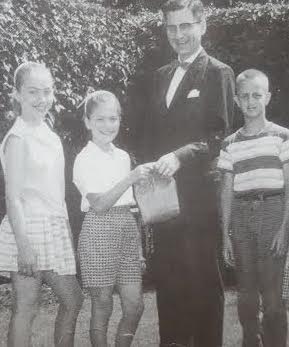 Even as a young girl, much of the diligence she would show later in her professional life were in evidence. In 1959, she organized backyard carnivals, sport competitions and gaming contests to raise money to raise funds, by nickels and dimes, on behalf of a local United Way campaign. It led to her first bit of publicity, appearing in a local newspaper photograph with other children handing over a paper bag of the money they raised. Hillary Rodham also worked as a babysitter both after school and during her vacation breaks, sometimes watching the children of migrant Mexicans brought to the Chicago area for itinerant work. Even as a young girl, much of the diligence she would show later in her professional life were in evidence. In 1959, she organized backyard carnivals, sport competitions and gaming contests to raise money to raise funds, by nickels and dimes, on behalf of a local United Way campaign. It led to her first bit of publicity, appearing in a local newspaper photograph with other children handing over a paper bag of the money they raised. Hillary Rodham also worked as a babysitter both after school and during her vacation breaks, sometimes watching the children of migrant Mexicans brought to the Chicago area for itinerant work.
|
|
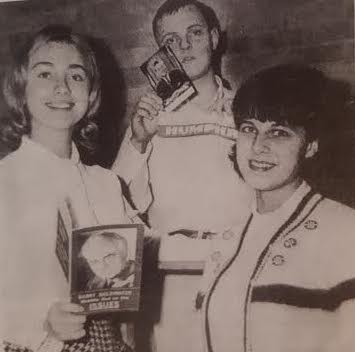
Ambitious at one point to become an astronaut, she wrote to NASA and received a response that stunned her when she was informed that women were not accepted for the astronaut program.
Influenced by her father's strong loyalty to the Republican Party, Hillary Rodham was active in a young Republican group. She actively campaigned for Republican presidential candidate Barry Goldwater in 1964. Also influenced by her mother, who was a Democratic, she was inspired to work in some form of public service after hearing a speech in Chicago by Reverend Martin Luther King.
In the summer of 1968, she was accepted into the Wellesley Internship Program in Washington, for nine weeks, assigned to work as an intern for the House Republican Conference. In that capacity, she was directly led by the future US President Gerald Ford, then serving as House Minority Leader, as well as congressmen Melvin Laird of Michigan and Charles Goodell of New York.
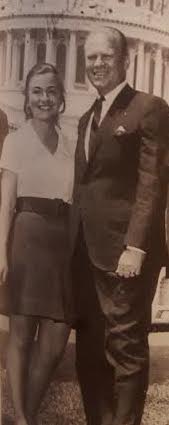 She was then invited by Goodell to continue working as an intern on behalf of New York Governor Nelson Rockefeller's last-minute presidential bid at the 1968 Republican National Convention in Miami, Florida. She attended the convention and watched as Richard Nixon was nominated for the presidency by his party. She was then invited by Goodell to continue working as an intern on behalf of New York Governor Nelson Rockefeller's last-minute presidential bid at the 1968 Republican National Convention in Miami, Florida. She attended the convention and watched as Richard Nixon was nominated for the presidency by his party.
In her senior year, she researched and wrote a thesis on Chicago community organizer Saul Alinsky. Although she agreed with his premise that the disadvantaged of society had to be empowered to help themselves, she did not agree that social change came about best from working outside the establishment but rather from within. Although he offered her a chance to work with him after she graduated, Hillary Rodham decided instead to attend law school and work from within the system.
She also worked at various jobs during her summers as a college student. In 1969, for example, she spent the summer washing dishes at a Denali National Park restaurant and sliming and boxing salmons in a canning factory in Valdez, Alaska fish factory.
In 1970, she secured a grant and first went to work for what would become the Children's Defense Fund. Part of her research work that summer involved the concurrent Senate hearings held by Senator Walter Mondale's (Minnesota Democrat) subcommittee on migrant workers, researching migrant problems in housing, sanitation, health and education. Upon her return to Yale Law School, Miss Rodham determined to commit her focus to studying the law and how it affected children.
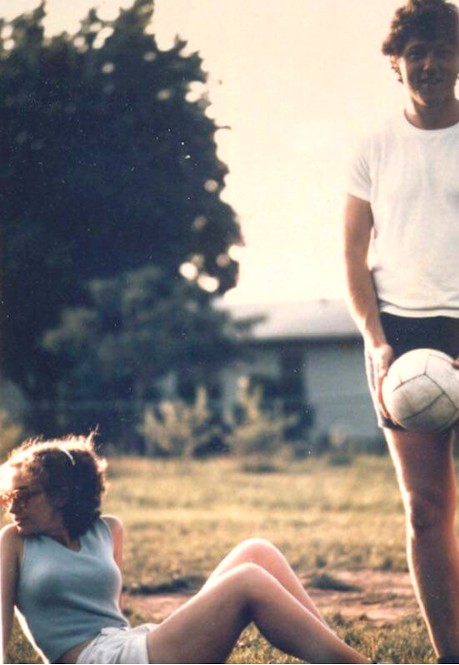 On the final day of her law classes in the spring of 1971, she met fellow law student Bill Clinton from Arkansas and had their first date by going to the Yale Art Gallery to see a Mark Rothko exhibit. In the summer of 1971, Hillary Rodham worked as a clerk at the small law form Treuhaft, Walker and Burnstein in Oakland, California. Bill Clinton, already declaring his love for her, followed Hillary Rodham and they lived in Berkeley, near the University of California campus. On the final day of her law classes in the spring of 1971, she met fellow law student Bill Clinton from Arkansas and had their first date by going to the Yale Art Gallery to see a Mark Rothko exhibit. In the summer of 1971, Hillary Rodham worked as a clerk at the small law form Treuhaft, Walker and Burnstein in Oakland, California. Bill Clinton, already declaring his love for her, followed Hillary Rodham and they lived in Berkeley, near the University of California campus.
Upon graduation from law school, she served as staff attorney for the Children's Defense Fund in Cambridge, Massachusetts. In the summer of 1972, however, she joined Bill Clinton, living in a series of western states working for the Democratic presidential candidate George McGovern's campaign.
In 1973 and 1974, while simultaneously working at the New Haven Legal Services during her post-graduate year at the Yale Child Study Center, she became exposed to severe cases of child neglect and abuse. The convergence of this work led her to help draft the legal process that the medical staff of the Yale-New Haven Hospital would use in dealing with cases where child abuse was suspected.
 Hillary Rodham's first published scholarly article, "Children Under the Law" was published in the Harvard Educational Review in 1974. The article explored the sensitive issues involving to what degree judicial and legal powers should intervene in cases of child abuse and neglect. Hillary Rodham's first published scholarly article, "Children Under the Law" was published in the Harvard Educational Review in 1974. The article explored the sensitive issues involving to what degree judicial and legal powers should intervene in cases of child abuse and neglect.
In the spring of 1974, she returned to Washington as a member of the presidential impeachment inquiry staff advising the Judiciary Committee of the House of Representatives during the Watergate Scandal. With Nixon's resignation in August of that year, the need for the continued work ceased.
|
|
Marriage:
 27 years old, married 1975, October 11, Fayetteville, Arkansas to William Jefferson "Bill" Clinton (born August 19, 1946, Hope, Arkansas), professor of law. 27 years old, married 1975, October 11, Fayetteville, Arkansas to William Jefferson "Bill" Clinton (born August 19, 1946, Hope, Arkansas), professor of law.
Although her education, legal and professional experience led to her being given a number of choices at well-paying and established New York and Washington law firms, she decided to instead "follow my heart" and go to the small-town of Fayetteville, Arkansas where her boyfriend Bill Clinton was working as a law professor at the University of Arkansas Law School. Hillary Rodham also joined the law school faculty there as assistant professor of law.
While they were dating, Bill Clinton secretly purchased a small house in Fayetteville that she had noticed and remarked that she had liked. When he proposed marriage to her and she accepted, he revealed that they owned the house. Their modest wedding ceremony and reception were held in their new home.
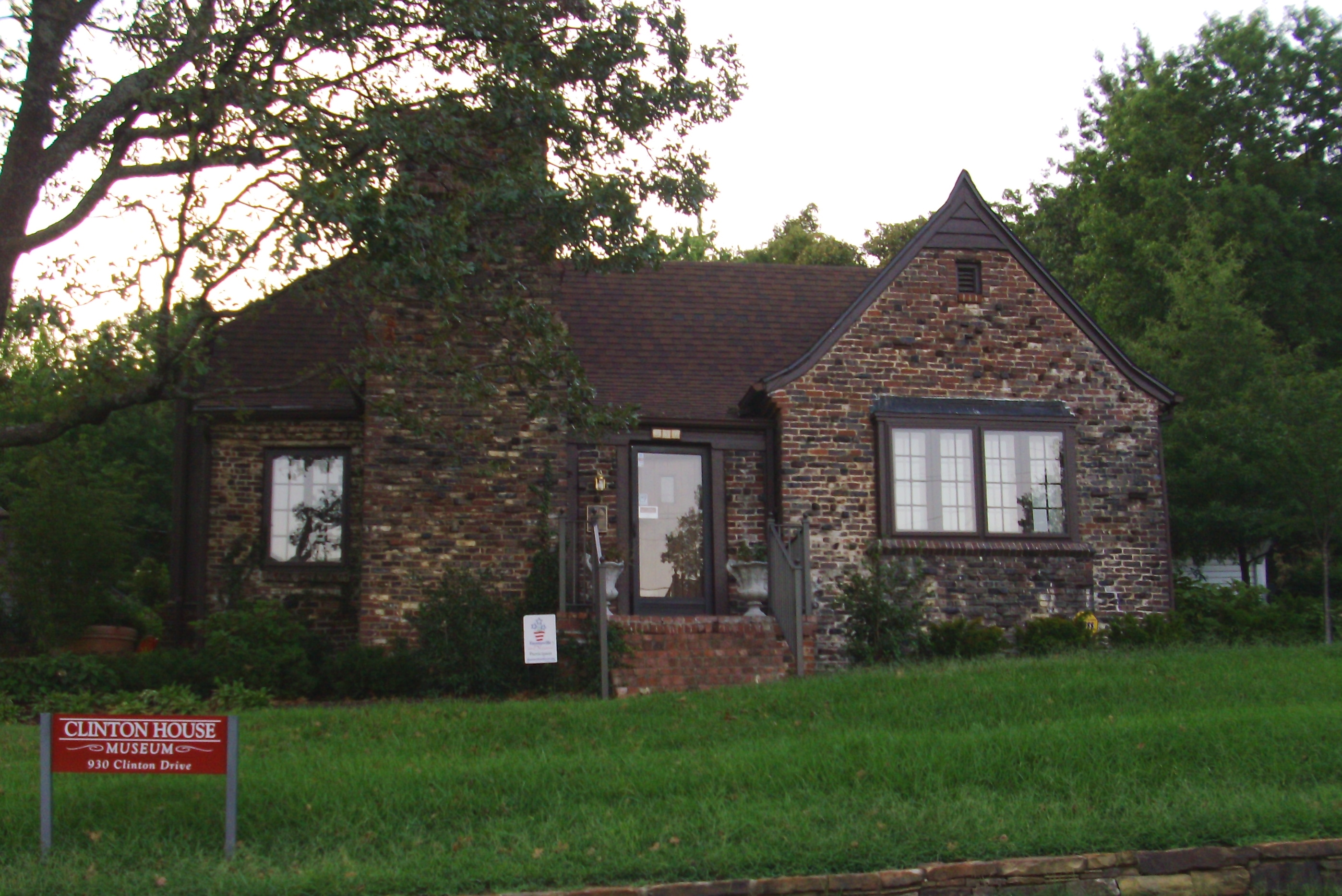
They married and lived here, briefly. Following Bill Clinton's election in 1976 as state attorney general, the couple relocated to the state capital of Little Rock, Arkansas.
In 1976, the newly married Hillary Clinton attended that year's Democratic National Convention in New York, which nominated Jimmy Carter as the party's presidential candidate. Carter asked Bill Clinton to head his campaign in Arkansas and asked Hillary Clinton to work as field coordinator in Indiana. After the couple took a two week vacation in Europe, she relocated to Indianapolis to work for Carter's campaign.
|
|
Children:
 One daughter; Chelsea Victoria Clinton One daughter; Chelsea Victoria Clinton
(born 1980, February 27)
|
|
Occupation after Marriage:
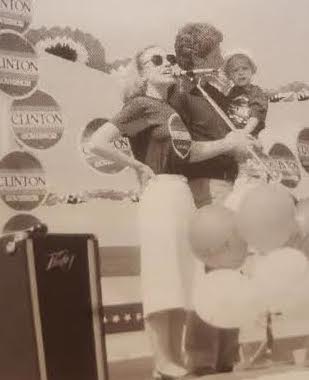 A year after her marriage, Hillary Clinton, retaining her maiden name for work, accepted an offer to join the Rose Law Firm in Little Rock, Arkansas becoming the old, established firm's first woman partner. In 1979, she became a full partner at the Rose Law Firm. She was twice named to the list of "The 100 Most Influential Lawyers in America." She also represented and later served on the board of Arkansas businesses including TCBY ("The Country's Best Yoghurt"), and Wal-Mart. A year after her marriage, Hillary Clinton, retaining her maiden name for work, accepted an offer to join the Rose Law Firm in Little Rock, Arkansas becoming the old, established firm's first woman partner. In 1979, she became a full partner at the Rose Law Firm. She was twice named to the list of "The 100 Most Influential Lawyers in America." She also represented and later served on the board of Arkansas businesses including TCBY ("The Country's Best Yoghurt"), and Wal-Mart.
In 1978, Bill Clinton was elected to the first of five of non-consecutive terms as Governor of Arkansas and Hillary Clinton, while retaining her job as an attorney, became the state's First Lady. Shortly after the gubernatorial inauguration, she granted a local television interview about her new life:
Finding a balance between the expected concessions to a far more traditional woman's role as the spouse of a governor in a southern state, yet remain genuine in terms of her own professional interests and pursuits was a difficult challenge for Hillary. She ceased using her maiden name exclusively
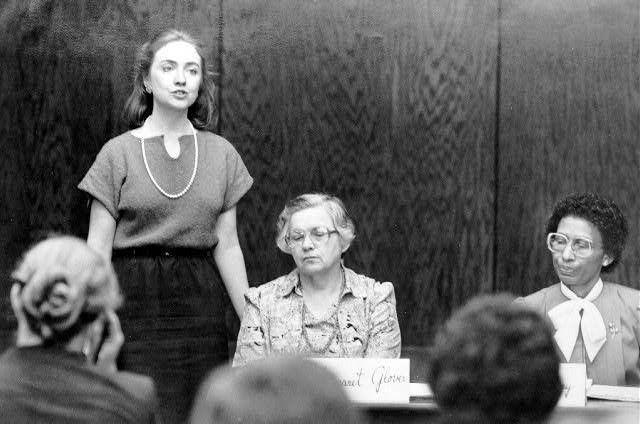 Along with her public duties, work as an attorney, wife and mother, in 1978, she also assumed a further public commitment, accepting the offer of President Carter of appointment to the Legal Services Corporation. Along with her public duties, work as an attorney, wife and mother, in 1978, she also assumed a further public commitment, accepting the offer of President Carter of appointment to the Legal Services Corporation.
As First Lady of Arkansas for twelve years, she chaired the Arkansas Educational Standards Committee, conducting county studies on teacher performance and student testing, and offering recommendations for overhauling the state system. Here is an excerpt of her introducing the issue of education from that time:
While the state's first lady, she also co-founded the Arkansas Advocates for Children and Families, and served on the boards of the Arkansas Children's Hospital, Legal Services, and the Children's Defense Fund. Mrs. Clinton wrote a weekly newspaper column entitled "Talking It Over."
|
|
Presidential Campaign and Inauguration:
During the 1992 Democratic primaries, several incidents occurred which proved to be the primary basis for much of the controversy and criticism that would be leveled at Hillary Clinton as First Lady.
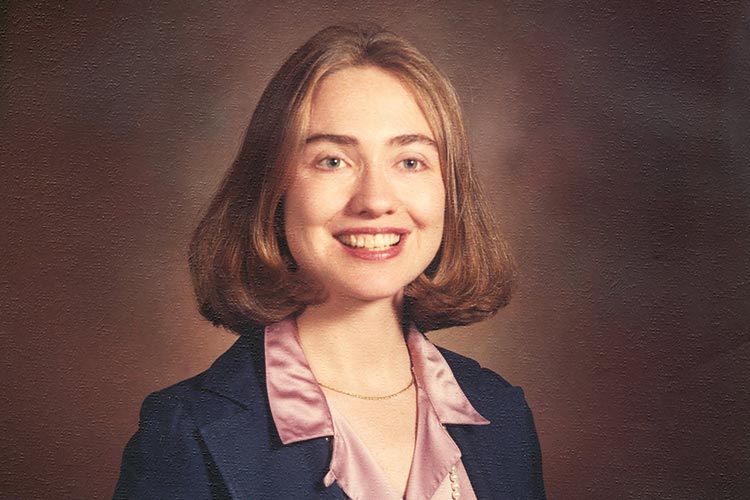 During a debate of the spring primary season, former California Governor Jerry Brown challenged Governor Clinton with suggestions that Hillary Clinton's work as an attorney involved state funds and was unethical, hinting in general terms that she had somehow profited from her husband's position. During a debate of the spring primary season, former California Governor Jerry Brown challenged Governor Clinton with suggestions that Hillary Clinton's work as an attorney involved state funds and was unethical, hinting in general terms that she had somehow profited from her husband's position.
Clinton himself remarked at the time that his wife would be a full partner if he became President, terming it a "two for one" deal. Finally, in response to some of these questions, Hillary Clinton sharply retorted to a journalist's question at a public appearance that was being covered by broadcast media that the only way a working attorney who happened to also be the governor's wife could have avoided any controversy would have been if she had "stayed home and baked cookies."
The remark, frequently replayed on television as a single clip from her more explicit response, sparked public debate as to whether she was intending to demean the role of stay-at-home mother. The controversy about Hillary Clinton becoming potentially the first First Lady who maintained a professional career while simultaneously working as a mother became the initial spark that led to a history of her as a recipient of oppositional press.
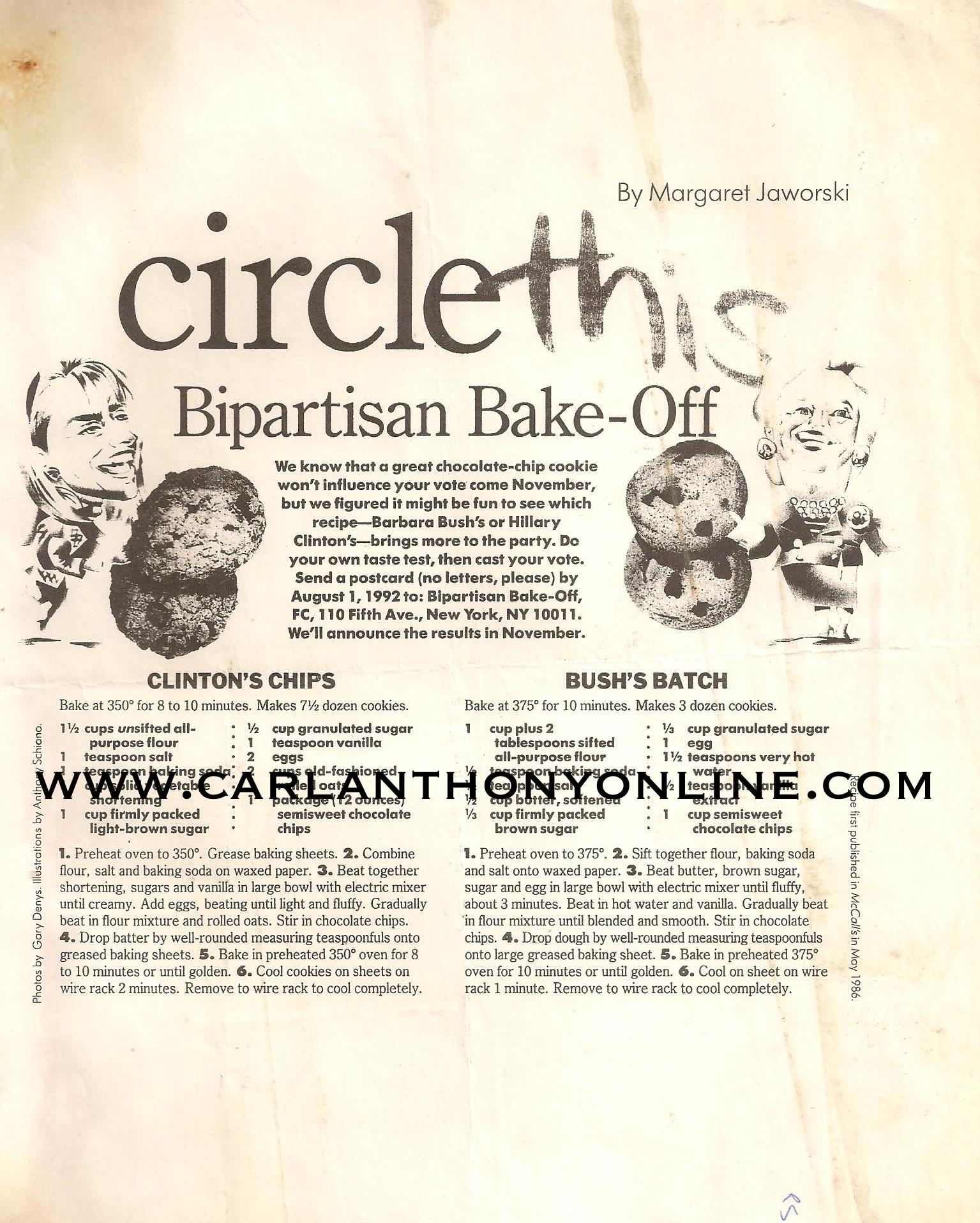
In a lighter tone, Family Circle magazine sponsored a cookie contest asking readers to vote for their choice of recipes used by the wives of the two presidential candidates, Barbara Bush and Hillary Clinton. The "cookie contest," as much a tongue-in-cheek tradition as one involving actual recipes, has remained a staple of the quadrennial political race.
Here is an NBC news report and interview with Hillary Clinton during the state primary elections:
Republican Party supporters who depicted her as the antithesis of "family values," a popular phrase of the GOP during the 1992 campaign further fueled the controversy about Hillary Clinton becoming a presidential spouse. At the 1992 Republican National Convention, conservative leader Pat Buchanan and vice-presidential spouse Marilyn Quayle referenced her 1974 article "Children Under the Law" in a way that suggested that she advocated an "ant-family" agenda of denying parental rights over children.
 Hillary Clinton did not address the National Democratic Convention in 1992. Four years later, however, as the incumbent First Lady, she gave a speech at the 1996 National Democratic Convention that struck a tone both personal and political, underlining some of the Administration's policy gains and its intentions for greater health care and education for children, and greater equality for women. Hillary Clinton did not address the National Democratic Convention in 1992. Four years later, however, as the incumbent First Lady, she gave a speech at the 1996 National Democratic Convention that struck a tone both personal and political, underlining some of the Administration's policy gains and its intentions for greater health care and education for children, and greater equality for women.
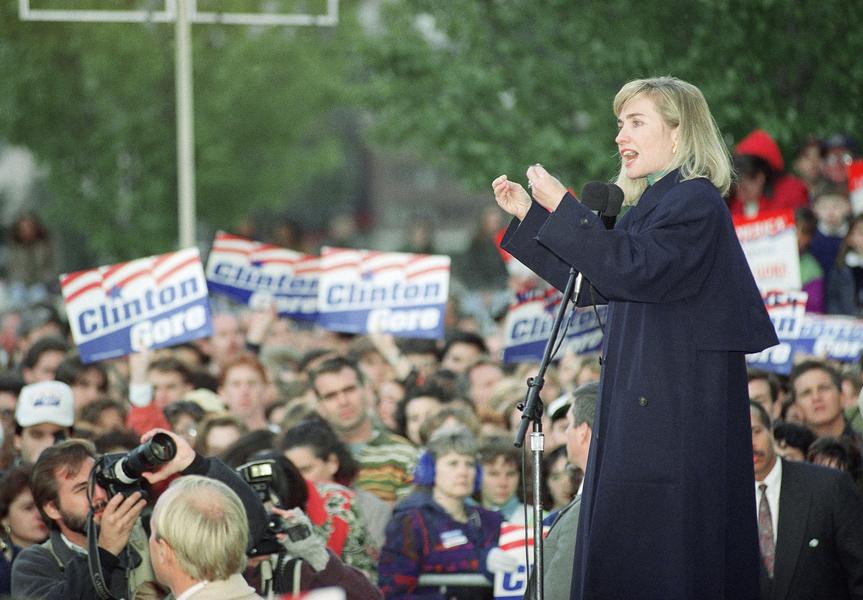
During the post-convention 1992 presidential campaign, however, Hillary Clinton assumed a highly active and overtly political role as a surrogate for the candidate, capable of discussing the details of legislative intentions her husband hoped to initiate as President, and providing statistical and other data to make her case, doing so not from notes but memory.
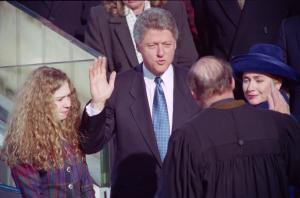 At the 1993 Inauguration, the Clintons created a new precedent by having a president-elect's child, their daughter Chelsea, join at the podium at the moment of the oath-of-office administration. At the 1993 Inauguration, the Clintons created a new precedent by having a president-elect's child, their daughter Chelsea, join at the podium at the moment of the oath-of-office administration.
The morning after the Inauguration, the Clintons decided to follow the 1989 precedent established by George and Barbara Bush and hosted an "open house" receiving line that ran through the White House ground floor, shaking hands and speaking with a limited number of the general public that had waited since the previous night for this opportunity. Here is footage of that event:
|
|
First Lady:
January 20, 1993 - January 20, 2001
45 years old
|
|
West Wing Office:
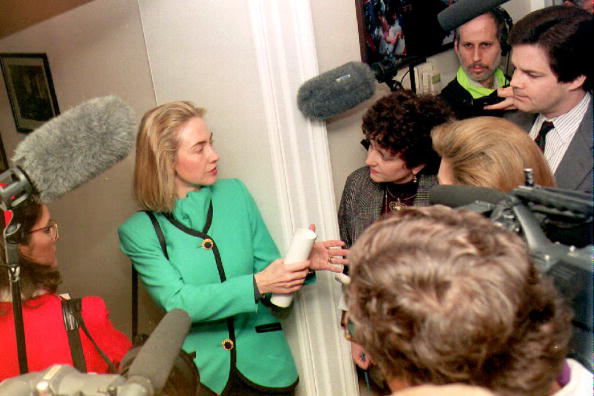 The first decision Hillary Clinton made, as First Lady was to establish her own working office in the West Wing. She did this in order to be accessible to executive staff working on legislative and other substantive matters in which she would herself be directly involved. Doing so shattered historic precedent, all of her predecessors having worked from offices located in the second floor family quarters or, in the case of Rosalynn Carter, in the East Wing. The first decision Hillary Clinton made, as First Lady was to establish her own working office in the West Wing. She did this in order to be accessible to executive staff working on legislative and other substantive matters in which she would herself be directly involved. Doing so shattered historic precedent, all of her predecessors having worked from offices located in the second floor family quarters or, in the case of Rosalynn Carter, in the East Wing.
|
|
The First Lady's Staff:
During the transition period, Hillary Clinton began to assemble a staff that would work with her for varying periods of the duration of her eight years as First Lady. Many would also continue to work with her as a United States Senator and then as a Secretary of State. During the 1992 campaign, one of her aides, Patti Solis Doyle, responded to a call with "Hillaryland," and the reference to those who worked with her became a catchphrase used to describe her White House staff. The staff was composed largely of women, but not exclusively, who had experience working for public interest and public service organizations. With her being so involved in policy, her staff was more fully integrated into the workings of the West Wing than that of any previous First Lady.
They occupied office space in the Old Executive Office Building, which was unprecedented. They were noticeable too for their absolute loyalty to the First Lady and her agenda, and known for never having been involved in any press leaks, or seeking offices that would suggest greater status.
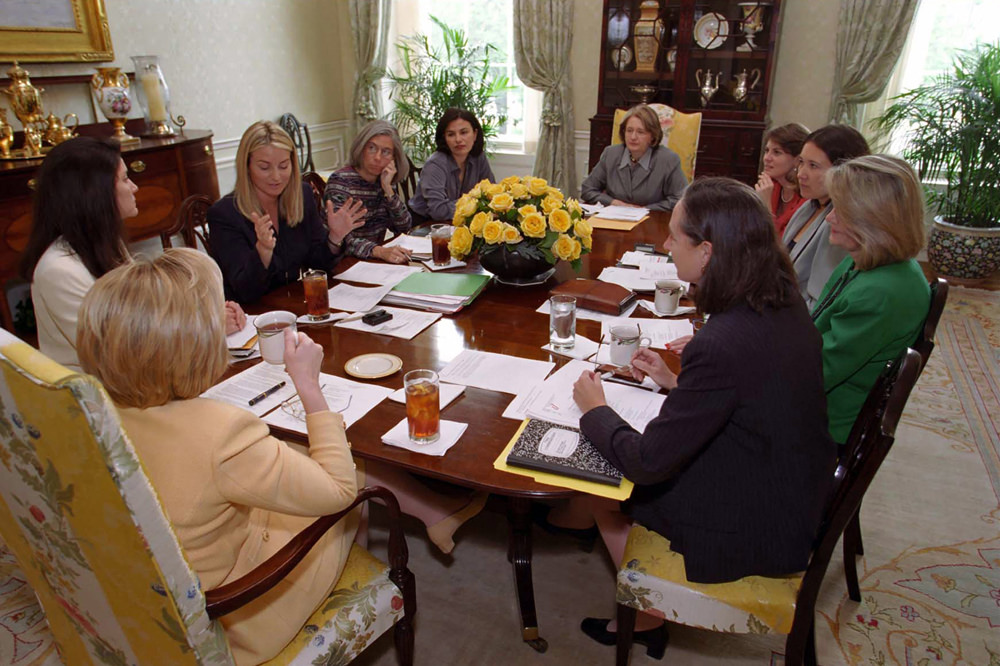
Her first Chief of Staff was Maggie Williams, who proved crucial to helping craft the initial legislative battle for health care reform. She was also the first member of a First Lady's staff to be given the title of Assistant to the President and was included in the President's senior staff meetings. Her first Deputy Chief of Staff, Melanne Verveer, later, became the Chief of Staff. A longtime trusted friend with experience in advocacy work, Verveer generated many of the original ideas for both domestic and global projects that sought to bring greater gender equity in matters of jobs, education, health and the workplace. Her consecutive Social Secretaries Ann Stock and Capricia Marshall created many large-scale events marked by innovative use of the White House complex. The First Lady's personal assistant Pam Cicetti worked closely with her in her West Wing office suite.
|
|
Health Care Reform:
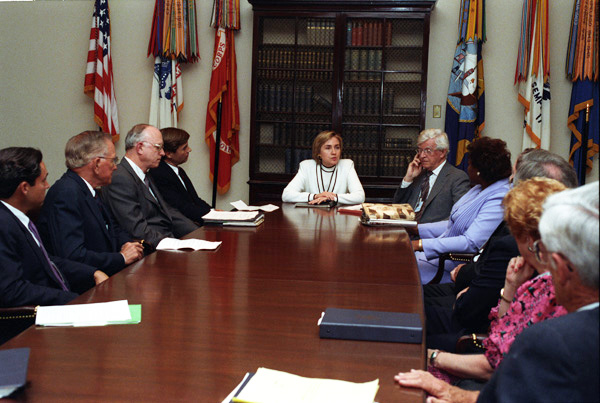
Within the first five days of becoming First Lady, Hillary Clinton was named by her husband to head the President's Task Force on Health Care Reform, overseeing research, investigatory trips, financial reports, numerous committees composed of medical and insurance professionals, lawmakers and other government officials, public service leaders, and consumer rights advocates. She also delivered a public service announcement on the issue:
When most of the meetings were conducted behind closed-doors, however, opposition was raised that it violated the government's so-called "sunshine laws" that required full public disclosure. There then ensued a legal debate on whether the unsalaried and unofficial role of a presidential spouse held a person in such a role to the same standards as a federal employee.
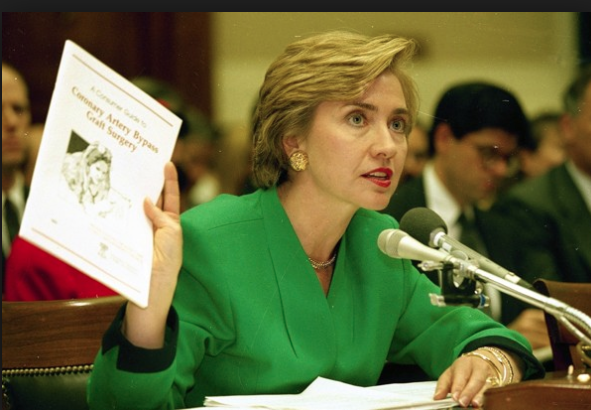
In this capacity, she became the third First Lady to testify before Congress, appearing to the House committee on health insurance reform in September 1993. Here is an excerpt of her testimony:
When the plan devised was attacked as too complicated or an intention leading to "socialized medicine" the Administration decided not to push for a vote and it never came to a vote in the Senate or House, abandoned in September of 1994.
Hillary Clinton's interest in the subject, however, had helped raise national consciousness about the growing problem of uninsured Americans, and began to address the issue by narrowing her focus on specific medical issues effecting a variety of demographics.
|
|
Health-Related Legislation and Funding:
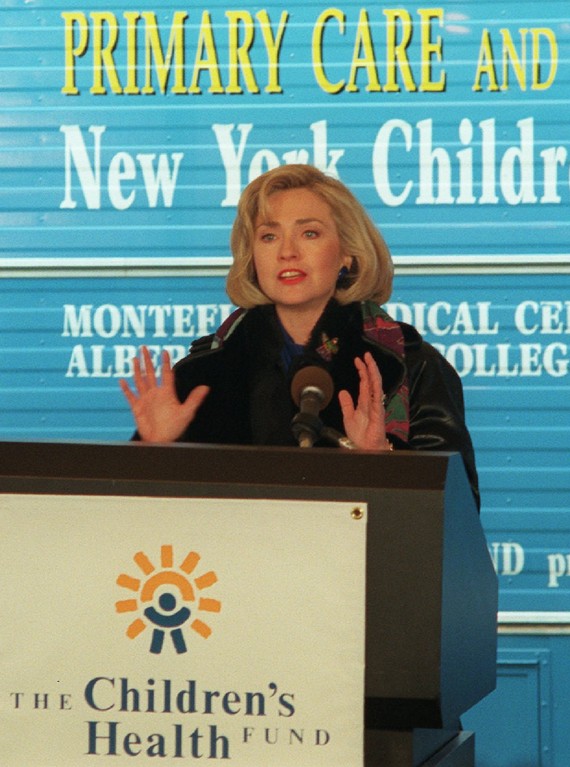
Perhaps the most successful component of her accomplishments as First Lady was initiating the Children's Health Insurance Program in 1997, a federal effort that provided state support for those children whose parents were unable to provide them with health coverage. Here is video footage of her speaking on children's health care at minute 9:00:
She also hosted numerous White House conferences that related to children's health, including early childhood development (1997) and school violence (1999). She lent her support to programs ranging from "Prescription for Reading," in which pediatricians provided free books for new mothers to read to their infants as their brains were rapidly developing, to nationwide immunization against childhood illnesses.
Hillary Clinton was a First Lady in the forefront on issues of women's health and equality. While she led supported an annual drive to encourage older women to seek a mammography to prevent breast cancer, coverage of the cost being provided by Medicare, many of her efforts on gender equality were simply blended into all of her other, larger efforts both domestic and international.
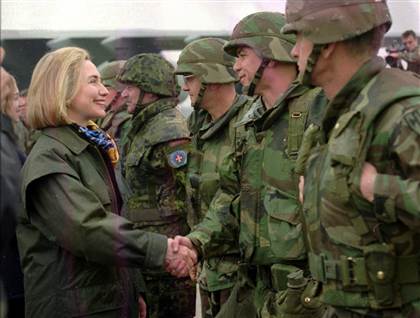 She also successfully sought to increase the research funding for illnesses such as prostate cancer, epilepsy and childhood asthma at the National Institute of Health. Further, the First Lady gave voice to the illnesses that were affecting veterans of the Gulf War, with the possibility of their suffering the toxic side effects of chemical "Agent Orange" used in warfare. It was during her numerous overseas trips when she met with members of the US Armed Services that she began to become more acutely aware of not just the physical but mental health challenges often faced by them and other defenders and responders of the public's safety. She also successfully sought to increase the research funding for illnesses such as prostate cancer, epilepsy and childhood asthma at the National Institute of Health. Further, the First Lady gave voice to the illnesses that were affecting veterans of the Gulf War, with the possibility of their suffering the toxic side effects of chemical "Agent Orange" used in warfare. It was during her numerous overseas trips when she met with members of the US Armed Services that she began to become more acutely aware of not just the physical but mental health challenges often faced by them and other defenders and responders of the public's safety.
|
|
Adoption Reform:
Although she assumed a less overt political role after the failure of the health care reform plan, the efforts on behalf of which she focused were fully public. She cited the Adoption and Safe Families Act of 1997 as the achievement she initiated and shepherded that provide her with the greatest satisfaction. Beginning with an article she wrote on orphaned children in 1995, through a series of public events on the issue, policy meetings with Health and Human Service officials, private foundation leaders, the drafting of policy recommendations, and eventually lobbying with legislators led to its passage.
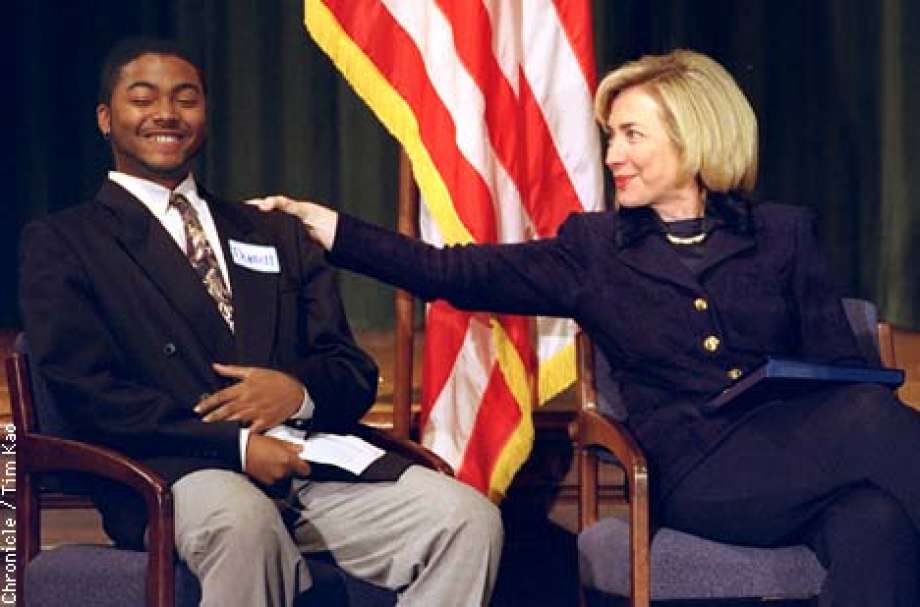
The First Lady led a second effort, the Foster Care Independence bill, aiding older children who had never been adopted to transition to adulthood. Further, she worked with organizations as diverse as Catholic Charities and Pro-Choice America to find consensus in effectively reducing the teenage pregnancy rate.
She appears in 1996 video footage with the President in the Oval Office discussing adoption reform with children:
|
|
Advisory Role:
 Having a West Wing office allowed the First Lady greater and regular access to the President and his senior staff. With her familiarity with the intricate political issues and decisions faced by the President, she openly discussed his work with him, yet stated that ultimately she was but one of several individuals he consulted before making a decision. They were known to disagree. Regarding his 1993 passage of welfare reform, for example, the First Lady had reservations about federally supported childcare and Medicaid. However different their solutions might be on how to best address an issue, the Clintons were nevertheless united in believing that it was important to resolve and would join in the agreed method of tackling it. Having a West Wing office allowed the First Lady greater and regular access to the President and his senior staff. With her familiarity with the intricate political issues and decisions faced by the President, she openly discussed his work with him, yet stated that ultimately she was but one of several individuals he consulted before making a decision. They were known to disagree. Regarding his 1993 passage of welfare reform, for example, the First Lady had reservations about federally supported childcare and Medicaid. However different their solutions might be on how to best address an issue, the Clintons were nevertheless united in believing that it was important to resolve and would join in the agreed method of tackling it.
When issues that she was working on were under discussion at the morning senior staff meetings, the First Lady often attended. Aides kept her informed on all pending legislation and oftentimes sought her reaction to issues as a way of gauging the President's potential response.
|
|
Working with Cabinet:
Weighing in on his Cabinet appointments and personally familiar with the experience of individuals appointed by the President, the First Lady developed a working relationships with many of them on issues of joint concern and also lobbied them on behalf of departmental changes There was a wide variety of examples.
She persuaded Treasury Secretary Robert Rubin, for example, to convene a meeting of corporate CEOs for their advice on how companies could be persuaded to adopt better child care measures for working families.
As a longtime colleague of educator Donna Shalala, Mrs. Clinton conferred on many proposed and pending pieces of health and social service legislation with her as Secretary of Health and Human Services, sometimes with contradiction but always in an effort towards a resolution of initiating the strongest possible proposals from the executive to the legislative branch.
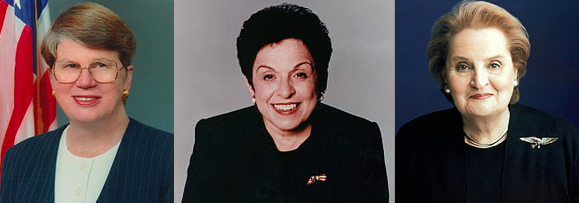 With Attorney General Janet Reno, the First Lady helped to create the Department of Justice's Violence Against Women office. With Attorney General Janet Reno, the First Lady helped to create the Department of Justice's Violence Against Women office.
One of her closest Cabinet allies was Secretary of State Madeleine Albright. Following her international trips, Hillary Clinton wrote a report of her observations for Albright. A primary effort they shared was globally advocating gender equity in economics, employment, health care and education.
|
|
Foreign Trips and Activism:
During her trips without the President to Africa (1997), Asia (1995), South America (1995, 1997) and the Central European former Soviet satellite nations (1997, 1998), Hillary Clinton emphasized "a civil society," of human rights as a road to democracy and capitalism.

As First Lady she also visited a combat zone, making a 1996 stop in Bosnia. Among her predecessors only Eleanor Roosevelt and Pat Nixon had done so.
|
|
Global Gender Equality:
Although she was the unelected spouse of the American President, she formed a network of global women leaders from around the world, those elected or appointed to high government roles within their nations.
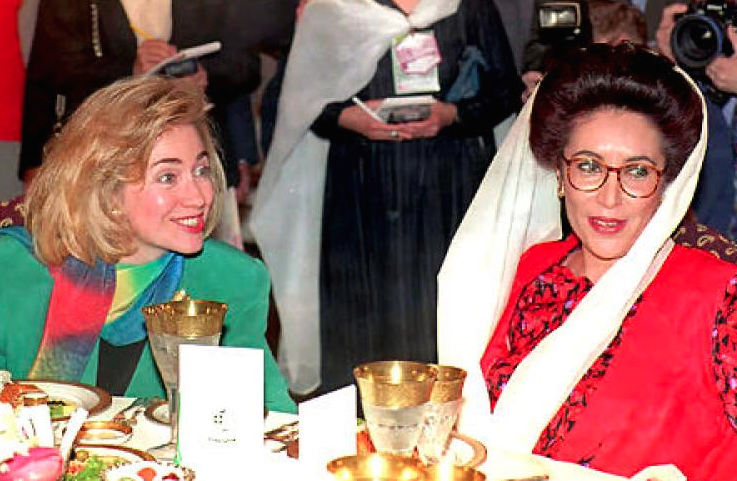
One of the programs she helped create was Vital Voices, a U.S.-sponsored initiative to promote the participation of international women in their nation's political process. A result of the group's meetings, in Northern Ireland, was drawing together women leaders of various political factions that supported the Good Friday peace agreement that brought peace to that nation long at civil war.
Both at home and abroad, the First Lady also began to speak out whenever she learned of the specific targeting of a female population of different nations by either institutionalized cultural traditions or by law. For example, she became one of the few international figures at the time, who publicly called out the violent and often fatal treatment of Afghani women by the Islamist fundamentalist Taliban that had seized control of Afghanistan.
Hillary Clinton was also an active supporter of the United States Agency for International Development (USAID), often awarding its micro-loans to small enterprises begun by women in developing nations that aided the economic growth in their impoverished communities.
 The First Lady further challanged the legality in parts of the Middle East of domestic violence and "honor killings" of women by their male family members, and of tribal genital mutilation in parts of Africa. Part of her agenda, coordinated with the State Department to multi-nation tours of regions of the world was specifically to raise national awareness of the value of women to the society at large, and how limiting their educational and professional opportunities damaged the entire country. The First Lady further challanged the legality in parts of the Middle East of domestic violence and "honor killings" of women by their male family members, and of tribal genital mutilation in parts of Africa. Part of her agenda, coordinated with the State Department to multi-nation tours of regions of the world was specifically to raise national awareness of the value of women to the society at large, and how limiting their educational and professional opportunities damaged the entire country.
|
|
1995 UN Conference on Women, Beijing:
 Perhaps the most important speech First Lady Hillary Clinton delivered was her September 5, 1995 address on global gender equality violations at the United Nations Fourth World Conference on Women in Beijing, China. It was a gathering of women from the globe's diverse national cultures united in their belief that, as Mrs. Clinton famously put it, "women's rights are human rights." In doing so, she became the first American dignitary to address China's violations on Chinese soil: Perhaps the most important speech First Lady Hillary Clinton delivered was her September 5, 1995 address on global gender equality violations at the United Nations Fourth World Conference on Women in Beijing, China. It was a gathering of women from the globe's diverse national cultures united in their belief that, as Mrs. Clinton famously put it, "women's rights are human rights." In doing so, she became the first American dignitary to address China's violations on Chinese soil:
"It is time for us to say here in Beijing, and the world to hear, that it is no longer acceptable to discuss women's rights as separate from human rights…It is a violation of human rights when babies are denied food, or drowned, or suffocated, or their spines broken, simply because they are born girls…when women and girls are sold into slavery or prostitution for human greed. It is a violation of human rights when women are doused with gasoline, set on fire and burned to death because their marriage dowries are deemed too small…when thousands of women are raped in their own communities and when thousands of women are subjected to rape as a tactic or prize of war….If there is one message that echoes forth from this conference, let it be that human rights are women's rights and women's rights are human rights, once and for all."
Although she did not reference China in her speech, she did make reference to its notorious "one child per family" policy and acceptance of the infanticide of baby girls and her subsequent commentary was intended to call out the Chinese government:
"Freedom means the right of people to assemble, organize, and debate openly. It means respecting the views of those who may disagree with the views of their governments. It means not taking citizens away from their loved ones and jailing them, mistreating them, or denying them their freedom or dignity because of peaceful expression of their ideas and opinions..."
Here is the First Lady's historic speech:
When she finished her remarks, the hall erupted in support of her remarks, although media coverage of it within China was banned. It is likely the most important one made by an American First Lady and drew as much attention as was hoped.
|
|
Controversy and Scandals:
Hillary Clinton encountered controversy from practically the beginning of her tenure.

By assuming a more overtly political role than any of her predecessors, Hillary Clinton became a customary target for the political opposition, used to symbolize the overall Administration and the Democratic Party; oftentimes she was personally attacked beyond the words she spoke or actions she took. Much as Nancy Reagan had served as a target for her husband's opponents, so too did Hillary Clinton become a target for those who disagreed with the Administration. The American Conservative Union, for example, solicited money to fight what they termed the First Lady's "radical agenda."
Not all of the controversy she engendered, however, was partisan. William Safire, the same New York Times columnist who had attacked Nancy Reagan for assuming unaccountable political power attacked Hillary Clinton on the same premise.
Much like Eleanor Roosevelt, the First Lady she most emulated and had studied, Hillary Clinton expected the partisan attacks as a result of activism. Like Eleanor Roosevelt, she wrote a newspaper column, a weekly syndicated piece, and made hundreds of speeches, oftentimes without notes.
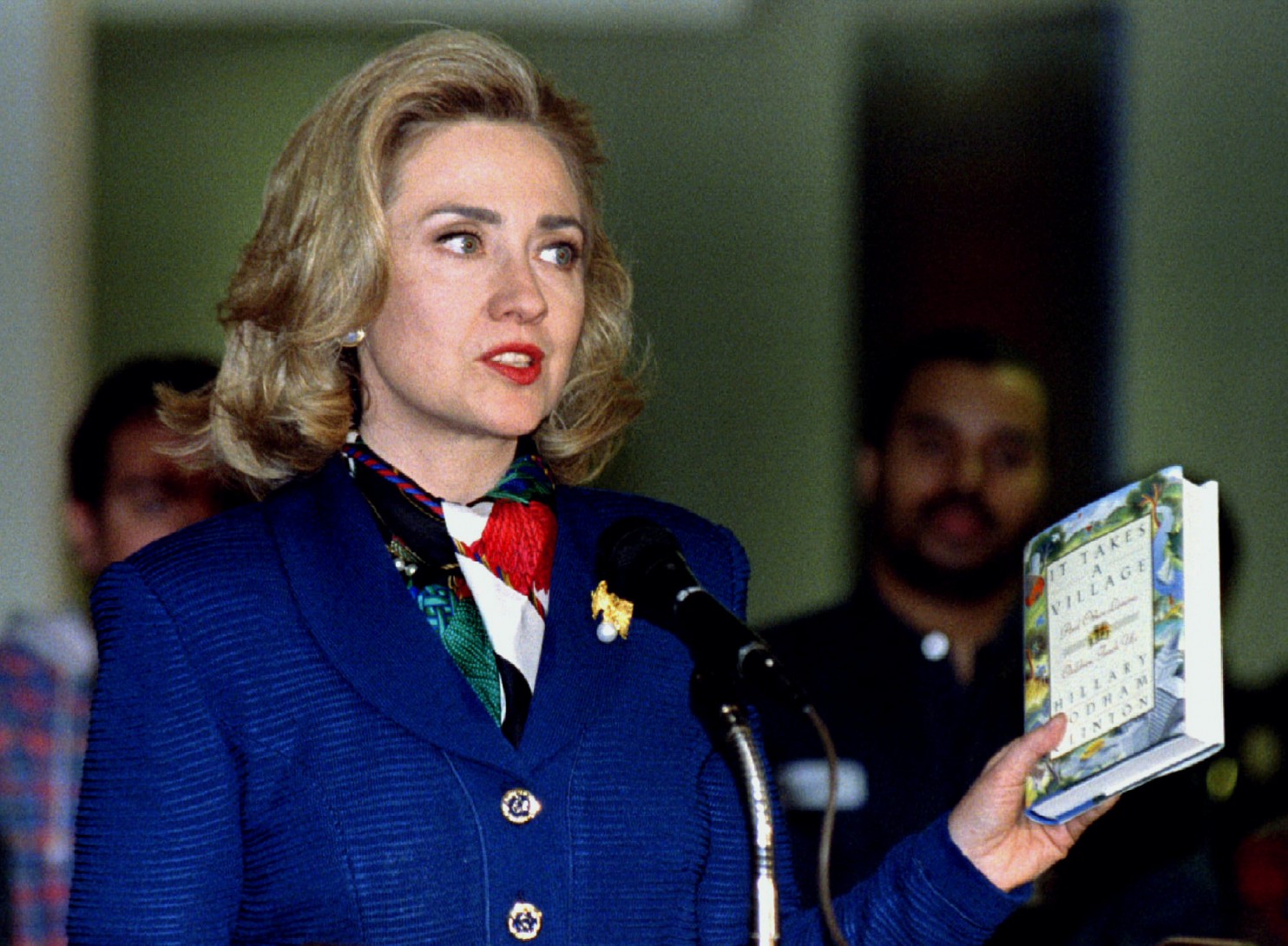 Also like Eleanor Roosevelt, she authored several books during her tenure. For the spoken word version of her book regarding family policies, It Takes a Village, Hillary Clinton was the recipient of the recording industry's Grammy Award. Also like Eleanor Roosevelt, she authored several books during her tenure. For the spoken word version of her book regarding family policies, It Takes a Village, Hillary Clinton was the recipient of the recording industry's Grammy Award.
Just five months into the Administration, with the firing of the White House travel office staff, followed by the suicide of Vincent Foster, White House counsel and friend and former law partner of the First Lady, Hillary Clinton found herself implicated in numerous investigations.
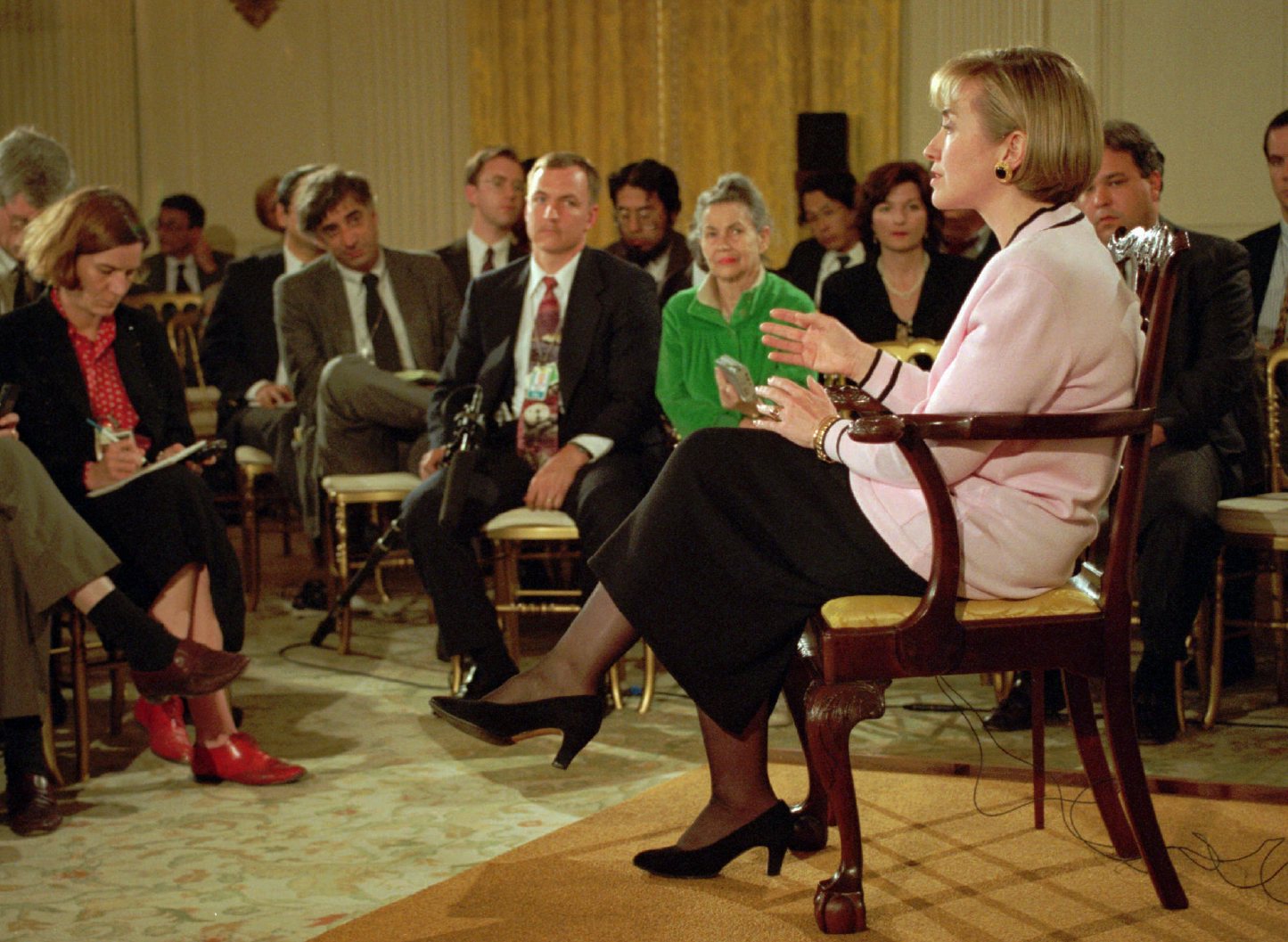
At the end of 1993, a story broke in the media that a Justice Department investigation into a failed Arkansas real estate venture, concerning a potential development in the Ozarks called "Whitewater," mentioned her as a potential witness in the inquiry; there were immediate suggestions in the opposition press that she had somehow illegally profited.
There was similar media speculation when it was disclosed that she had greatly profited in trading cattle futures through an experienced investor. All of this concerned matters long before her husband had sought the presidency in 1992 campaign.
The First Lady held an April 22, 1994 press conference in which she explained the details as proof of her not having taken any illegal actions. Political pressure, however, led to the President's appointment of a special prosecutor to investigate the charges, a move the First Lady opposed. Wearing a pink suit, it became known as the "pink press conference." Here is the first part of that press conference:
 On January 26, 1996, she testified before a grand jury concerning the Whitewater scandal. Over time, the parameters of the investigation would enlarge to include other charges made against the President and First Lady that were questionable in their validity. In every case, the investigations led to no criminal charges against Hillary Clinton. Here are her remarks following her testimony: On January 26, 1996, she testified before a grand jury concerning the Whitewater scandal. Over time, the parameters of the investigation would enlarge to include other charges made against the President and First Lady that were questionable in their validity. In every case, the investigations led to no criminal charges against Hillary Clinton. Here are her remarks following her testimony:
In time, the personal behavior of the President during an illicit affair with White House intern Monica Lewinsky would be the only charge in which he would be found guilty, leading to the historic articles of impeachment brought against him in late 1998, of which he was acquitted in February of 1999.
During the Lewinsky scandal, Hillary Clinton supported her husband's contentions of innocence regarding marital infidelity, believing the rumors, along with the other charges, to be the result of a "vast right-wing conspiracy."
In August 1998, however, when independent counsel Kenneth Starr questioned the President directly in the White House, he confessed that he had lied regarding the extent of the affair.
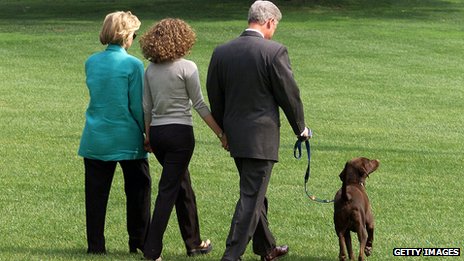
Hillary Clinton later admitted to being deeply wounded personally yet focusing on the public repercussions of the President's disclosure, made a strong statement of commitment to him and the Administration, believing a private matter had been wrongly turned into a political attack.
 Her support of him at that critical juncture was believed by many media commentators at that emotionally heightened time to be an important factor, if not the greatest factor, in preventing a call for his resignation. Her support of him at that critical juncture was believed by many media commentators at that emotionally heightened time to be an important factor, if not the greatest factor, in preventing a call for his resignation.
|
|
Interest in First Lady History:
 In large part, Mrs. Clinton came to grasp the contradictory symbolism of the "mythological" role she inherited by studying closely the First Lady role, an endeavor she began during the 1992 presidential campaign. In large part, Mrs. Clinton came to grasp the contradictory symbolism of the "mythological" role she inherited by studying closely the First Lady role, an endeavor she began during the 1992 presidential campaign.
Initially, much of her reading was about Eleanor Roosevelt and she consumed not only the books and articles the former First Lady had authored, but biographies and studies of her
She also had a strong affinity for Dolley Madison, admiring her act of bravery in saving national treasures before the British burned the White House during the War of 1812. During her tenure, she visited the Madisons''s Virginia home, launched the sale of a government coin commemorating her predecessor, and even once costuming herself during her annual birthday-Halloween party as Mrs. Madison.
Further, she read the biographies of earlier predecessors such as Edith Roosevelt, Mary Lincoln, Edith Wilson, Florence Harding, Abigail Adams, Louisa Adams and Nellie Taft.
|
|
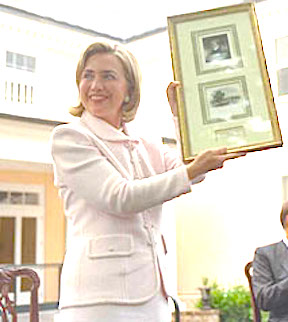 Hillary Clinton's interest in the multi-faceted aspects of her role, the women who had held different forms of power and influence before her while holding it, and the larger national and international contexts that could be understood by studying it led her to play an important role in the creation of the National First Ladies' Library. Hillary Clinton's interest in the multi-faceted aspects of her role, the women who had held different forms of power and influence before her while holding it, and the larger national and international contexts that could be understood by studying it led her to play an important role in the creation of the National First Ladies' Library.
The NFLL was the idea of a congressional spouse, Mary Regula, an educator and advocate of gender equity. She sought the advice and support for her vision of a national center of historical study of First Ladies, with a mission to educate the public by providing ongoing and new research.
Reaching a far larger, global audience than just a traditional museum or library, through its website, this more contemporary form of sharing information was of especial interest to Hillary Clinton. She recommended a bibliographer and historian, and agreed to serve as honorary chair of the fundraising effort, prompting all other living First Ladies to also do so.
 When the earliest version of the website was completed, Hillary Clinton hosted an East Room event that connected it to the Internet, becoming the first to access information on it. When the earliest version of the website was completed, Hillary Clinton hosted an East Room event that connected it to the Internet, becoming the first to access information on it.
To announce the NFLL qualifying for a federal matching funds grant, the First Lady would later come to the physical location in Canton, Ohio where visitors could attend lectures and conferences and tour the restored National Park Site home of President William McKinley that was, in fact, the home of his wife and her family.
|
|
Interest in American History:
As a native of Illinois, the "land of Lincoln," it was an early childhood introduction to the life of the sixteenth president that Hillary Clinton credited as the inspiration for her lifelong interest in American history. "Lincoln had a very big place in my historic imagination," she recalled in 1994. She travelled with her family to his home in Springfield, Illinois and other sites associated with him. She "focused on Lincoln as the savior of the union," yet on childhood trips to Alabama she came to recognize the different perspective offered by regional culture, leading to her effort to understand historical events from an integrated perspective. She felt similarly about George Washington's value as a hero, who was cast for her as "founder of the union" while a student.

In later years, she reflected on the importance of using the heroic words and deeds of historical figures as a way of unifying national values and to widen such examples to more inclusively reflect both genders and those from different professions, regions, socioeconomic levels and origins.
She had an especially substantive understanding of the institution of slavery, its impact on regional and national economics and long fight for abolition, the effect of late 19th century technology on manufacturing, the economy and immigration, and the women's rights movement, among other topics.
With a lifelong interest in regional American history, she initiated the Save America's Treasures program, a national effort that matched federal funds to private donations to rescue from deterioration and neglect, or restore to completion many iconic historic items and sites.

These included: the original Fort McHenry flag that inspired the Star Spangled Banner, a 17th century Dutch Reformed Church, the Lowell Observatory, New Mexico's Palace of the Governors, Iroquois Nation long house, San Esteban del Rey and Acoma Pueblo, Mesa Verde National Park, the National Historic Site of Seneca Falls, the M'Clintock House, the Chess Records Studio, architect Frank Lloyd Wright's home and studio, the archives and musical instruments of Louis Armstrong, the homes of authors Edith Wharton and Heney Wadsworth Longfellow, abolitionist Harriet Tubman, Kate Mullany, Thomas Edison's invention factory, the Golden Gate Park conservatory, the Colonial Theater of the Berkshires, the oldest standing African-American church, and the Pullman National Historic District.
As part of the Millennium Project which she initiated, monthly lectures that considered both America's past and forecasted its future were held in the East Room, and one of these became the first live simultaneous webcast from the mansion.
|
|
White House Refurnishing & Additions:
 In the east garden of the White House South Lawn, known as the Jacqueline Kennedy Garden, Hillary Clinton initiated the first Sculpture Garden, which displayed a rotating exhibition of large contemporary American works of art loaned from museums. In the east garden of the White House South Lawn, known as the Jacqueline Kennedy Garden, Hillary Clinton initiated the first Sculpture Garden, which displayed a rotating exhibition of large contemporary American works of art loaned from museums.
In the White House state rooms, she placed on rotating display the donated handicrafts (pottery, glassware, etc.) of contemporary American artisans. It was also at her initiative that the first contemporary work of art, a canvas painting by Georgia O'Keefe, was placed on public display in one of the White House state rooms, breaking the custom of only having antiquities there.
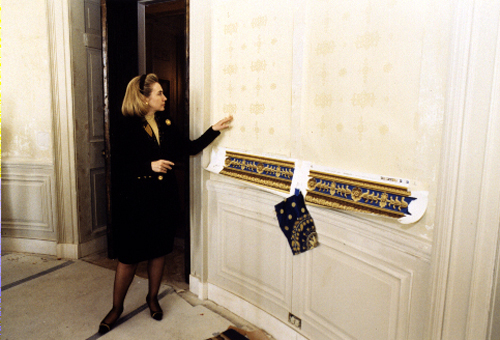
Mrs. Clinton also oversaw the restoration of the Blue Room on the state floor, the Lincoln Study on the second floor, and refurnishing of the Treaty Room into the President's Study, which had been unchanged for three decades.
With her interest in the White House deepening the longer she lived there, as the years of her husband's presidency went on, Hillary Clinton often liked to work in either one of the two oval spaces of the mansion, either the third-floor solarium or out on the shaded Truman Balcony of the South Portico. She continued to keep her West Wing office, but found she accomplished more work in the family quarters.
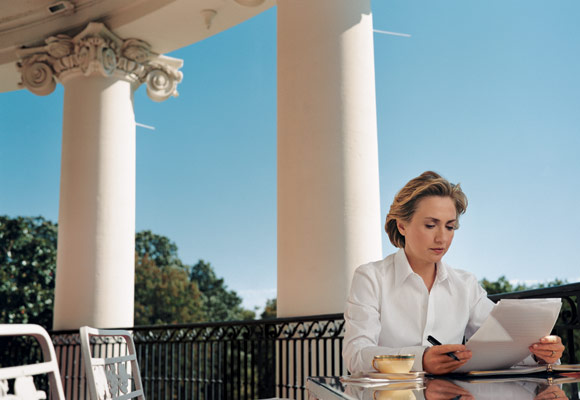
|
|
White House Entertaining Innovations:
Using a unique venue of large white tents on the South Lawn that could accompany several thousand guests, she hosted many large entertainments, such as a St. Patrick's Day reception, a state dinner for visiting Chinese dignitaries, and a contemporary music concert that raised funds for music education in the public schools. Although Pat Nixon had done this for a large POW dinner and Betty Ford also did so for the Bicentennial state dinner in honor of Queen Elizabeth, Hillary Clinton hosted a record number of events, both formal and informal, in the South Lawn tents. The first large-scale entertaining venue they hosted in South Lawn tents was a Jazz Festival in tribute to the famous one held in Newport, Rhode Island. Here is an introduction of it by the Clintons:
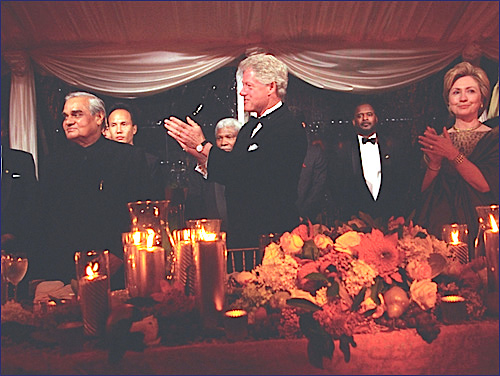
For all the foods served in the White House, she hired a chef whose expertise was in American regional cooking. She also hosted a massive New Year's Eve party on the turning of the 20th century into the 21st century, with legendary Americans from the worlds of politics, science, entertainment, sports and other fields as honored guests.
In November 2000, Hillary Clinton hosted a Bicentennial of the White House state dinner, an event at which more former First Family members were gathered together in the mansion than at any other time in its history, including Lady Bird Johnson, Gerald and Betty Ford, Jimmy and Rosalynn Carter, George and Barbara Bush, John Eisenhower, and Ethel Kennedy.
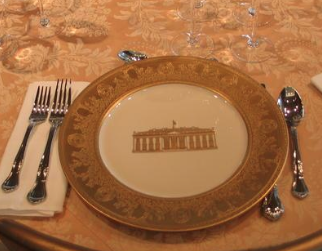 For that occasion, she made first use of a newly purchased state china, created in a gold-rimmed pattern using the imprint of the White House to commemorate the historic anniversary. For that occasion, she made first use of a newly purchased state china, created in a gold-rimmed pattern using the imprint of the White House to commemorate the historic anniversary.
|
|
Fashion Style & Popular Culture:
Becoming First Lady at age 45 years old, the initial visual appearance of Hillary Clinton was marked by her use of a headband in her hair. Seemingly ubiquitous throughout the 1992 campaign and the early years of her White House tenure, for those in the business of judging larger meaning from the clothing style of First Lady, Hillary's headband came to symbolize the working woman who had to juggle disparate responsibilities between the workplace and home.
It was an authentic representation, for Mrs. Clinton readily admitted that since the age of fourteen years old she had been working and had neither the time or, at first, the money to lavish on anything but the most practical clothes and accessories, her headband chosen not to set a trend or stir appeal or approval but simply the easiest way to keep her longer hair and bangs in place for a professional appearance. As First Lady, she enjoyed changing her hairstyles frequently, although some took this as a sign of uncertainty about her chosen identity. The degree of public discourse on the subject prompted her to quip, "If I want to get Bosnia off the front page all I have to do is change my hair."
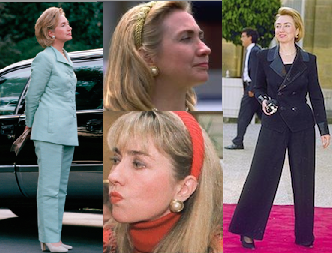 Towards the second part of her tenure, Hillary Clinton also began to appear more frequently in evening pants suits, wearing these as formal wear, almost always in black, adorned with beading and often with a frilled white shirt. As her global travel increased in 1997 and domestic travel in 1998, she began appearing often in pants suits of shades of somber blues, browns, and greys simply as a matter of practicality suited for such mobile activity. While one of her first public appearances in these suits was the peacock blue one she donned when addressing the 1996 Democratic National Convention, millions of viewers only saw the top part of her clothing, as she was televised from behind a speaker's podium. Towards the second part of her tenure, Hillary Clinton also began to appear more frequently in evening pants suits, wearing these as formal wear, almost always in black, adorned with beading and often with a frilled white shirt. As her global travel increased in 1997 and domestic travel in 1998, she began appearing often in pants suits of shades of somber blues, browns, and greys simply as a matter of practicality suited for such mobile activity. While one of her first public appearances in these suits was the peacock blue one she donned when addressing the 1996 Democratic National Convention, millions of viewers only saw the top part of her clothing, as she was televised from behind a speaker's podium.
By the time of her run for a United States Senate seat, these suits were more often in brighter and pastel shades. In the decades since the end of the Clinton presidency, Hillary Clinton was ubiquitous in her pants suits and the outfit became indelibly iconic as her own. While she had never intended to popularize a style of clothing for American women, she did reflect the generation encouraged to appear more individualistic within certain boundaries, beyond the first one of 1970s feminists and 1980s professional women who were expected to appear in feminine versions of male suits.

In numerous other ways, Hillary Clinton did mirror aspects of the popular culture of the century's last decade, from inviting the "lifestyle" trendsetter and merchandiser Martha Stewart to decorate the White House during the holiday season to joining in a demonstration of the 1996 novelty dance song "The Macarena" with her modified version of it, to frequently expressing her wonder and concern about the effect on society in general and children specifically of the unstoppable and rapid evolution of the "cyber" technology of the Internet, emails and mobile phones.
|
|
Family Life:
Although she had appeared in a taped interview as part of her father's convention biography film, Chelsea Clinton's presence on the Inaugural stand proved to be the most public role played by this presidential daughter until she briefly served as a surrogate First Lady during a 1999 state visit to Australia with her father.
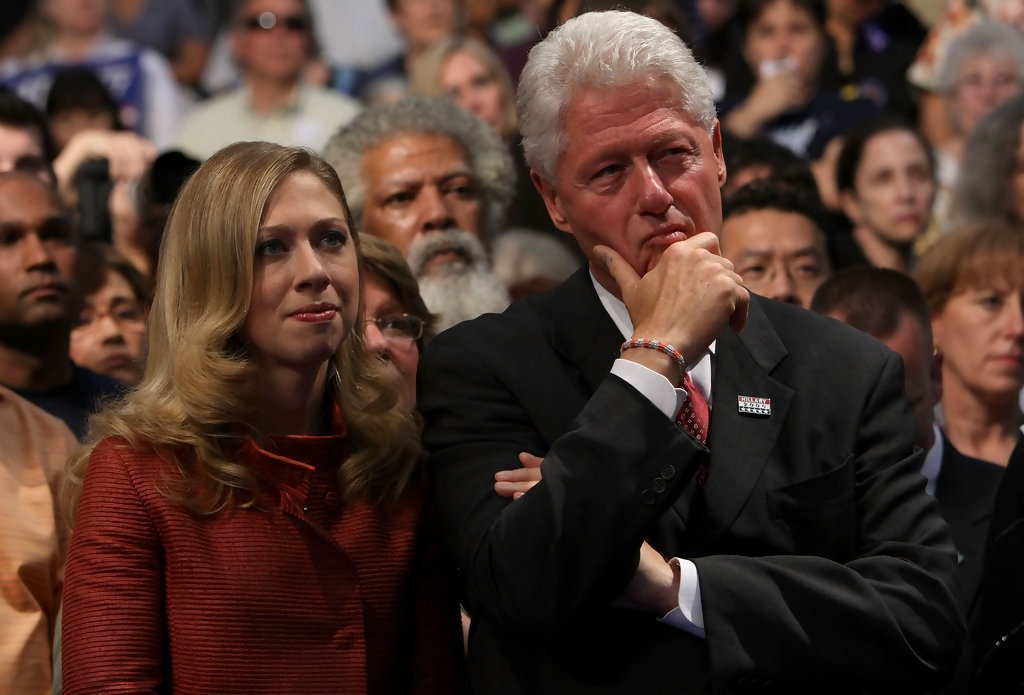
As First Lady, Hillary Clinton drew a strong "zone of privacy" boundary about media coverage concerning her daughter, a restriction maintained and respected by the media. It set a new precedent of limited press coverage of presidential children, in contrast to the preceding decades when those like the daughters of LBJ and Nixon assumed high public profiles.
Although the public identified the Clinton First Family as consisting of the President, First Lady and their daughter, there were often numerous other family members in residence at the White House, gathered for long weekends and holiday periods. Notably these included Dorothy Rodham, the First Lady's mother, and Hugh Rodham and Tony Rodham, her brothers.

During the Clinton presidency, Tony Rodham became one of the few members of First Families to have a White House wedding, marrying Nicole Boxer, the daughter of California U.S. Senator Barbara, in the Rose Garden. Their son Zachary Rodham, along with Tyler Clinton, the young son of the President's brother Roger were the two little children of this White House, often visiting at the same time.
Although the President's mother Virginia Kelley died of breast cancer just a year into his presidency, her widowed husband Richard Kelley, the president's stepfather, was always still included in family gatherings.
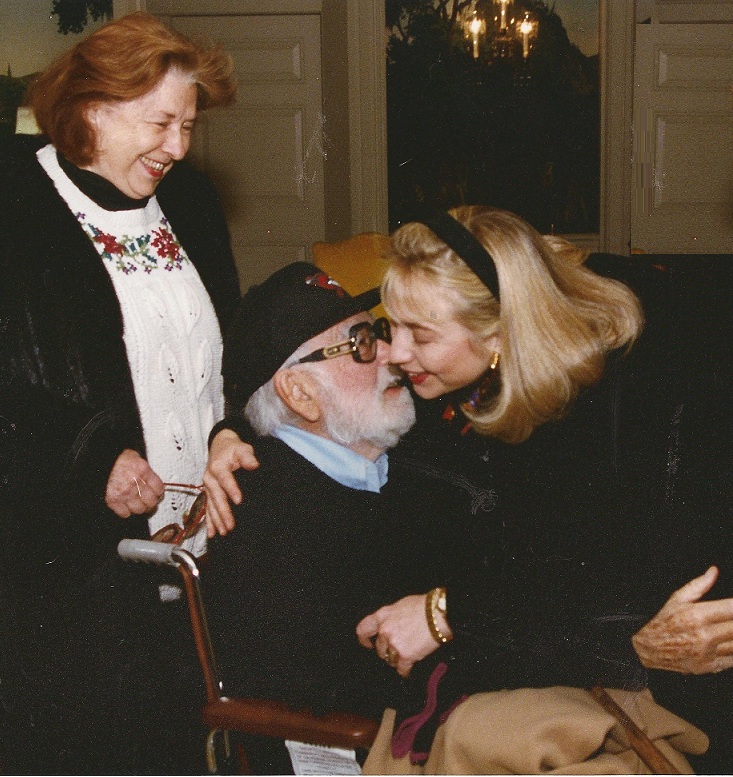
Despite his deteriorating health, Hillary Clinton's father Hugh Rodham was able to attend the 1993 Inauguration; he died less than three months later.
The family also enjoyed the company of a cat, Socks, brought from their Arkansas home, and dog, Buddy. Here is a compilation of video clips showing the unusually popular White House pets:
|
|
Relationship with Other First Ladies:
Prior to Bill Clinton's nomination, one of his earliest and most ardent supporters Jacqueline Kennedy Onassis invited Hillary Clinton to her apartment in New York, the former First Lady found herself intrigued by this different type of potential presidential spouse and they formed a strong friendship.
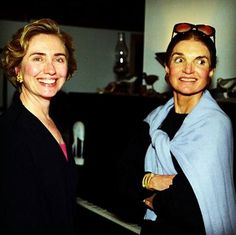 After the election, Kennedy-Onassis offered advice on how Hillary Clinton might raise her daughter in the White House in a way that would largely leave her unspoiled, drawing on techniques she used with her children. She also mused with her over the expectations placed on First Ladies and the need to affirm one's individualism in the role. They kept in touch by phone and in writing, Clinton joining Kennedy-Onassis for lunch at her apartment on occasion. After the election, Kennedy-Onassis offered advice on how Hillary Clinton might raise her daughter in the White House in a way that would largely leave her unspoiled, drawing on techniques she used with her children. She also mused with her over the expectations placed on First Ladies and the need to affirm one's individualism in the role. They kept in touch by phone and in writing, Clinton joining Kennedy-Onassis for lunch at her apartment on occasion.
The two First Ladies also enjoyed sharing a several hour vacation cruise and ocean swimming, as well as dinners and lunches during the summer of 1993. Kennedy-Onassis also invited Clinton to join her in attending a ballet performance in New York, but the incumbent First Lady's schedule prevented her from going.
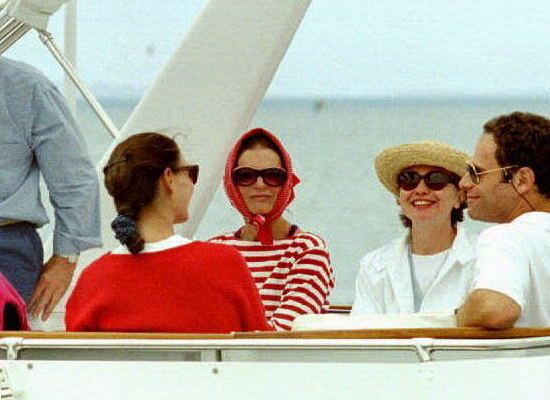 Although she had often turned down invitations from various presidents to visit the White House, Kennedy-Onassis told Clinton that she was seriously considering accepting the invitation to visit her there; weeks later, however, she first became sick with her final illness and was unable to ever return to the White House. Mrs. Clinton was invited to attend her funeral in New York. Here is a news clip of the First Lady and President upon news of her death: Although she had often turned down invitations from various presidents to visit the White House, Kennedy-Onassis told Clinton that she was seriously considering accepting the invitation to visit her there; weeks later, however, she first became sick with her final illness and was unable to ever return to the White House. Mrs. Clinton was invited to attend her funeral in New York. Here is a news clip of the First Lady and President upon news of her death:
Mrs. Clinton first got to know Lady Bird Johnson in the spring of 1993 when the First Lady accepted the invitation of the latter's former press secretary Liz Carpenter, to speak at the LBJ Library. They shared an interest in regional American history, and continued to see one another and speak of their mutual interest up through the December 2000 state dinner in honor of the White House bicentennial, the last time they were known to see each other.
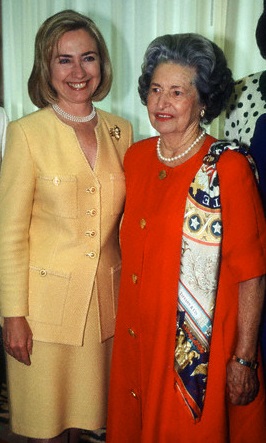 By the time Hillary Clinton became First Lady, Pat Nixon was exceedingly frail and died six months after the Clinton inaugural. Despite her absence from Mrs. Nixon's funeral being blamed on a previous commitment to her daughter, Hillary Clinton's failure to attend was criticized by many bipartisan commentators. By the time Hillary Clinton became First Lady, Pat Nixon was exceedingly frail and died six months after the Clinton inaugural. Despite her absence from Mrs. Nixon's funeral being blamed on a previous commitment to her daughter, Hillary Clinton's failure to attend was criticized by many bipartisan commentators.

Betty Ford first met with Hillary Clinton in April of 1993 on a substantive matter, when she lobbied her successor, then in the midst of spearheading health care reform; Mrs. Ford made the case to her for coverage of drug and alcohol recovery as part of national health insurance.
The women became especially close during Hillary Clinton's first summer as First Lady, in 1993; the Clintons spent part of their summer vacation in Beaver Creek, Colorado, living in a home just two doors down from Betty Ford and her husband, at their summer house there. The two First Ladies and their husbands attended a Bolshoi ballet performance together at that time and the two First Ladies were then induced to join the dancers onstage and toss roses to the cheering audience.
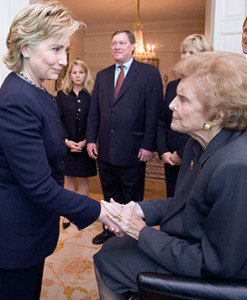 During the Clinton impeachment trials, Mrs. Ford frankly yet sympathetically addressed what she believed was a degree of denial on the part of Mrs. Clinton. During the Clinton impeachment trials, Mrs. Ford frankly yet sympathetically addressed what she believed was a degree of denial on the part of Mrs. Clinton.
When Betty Ford hosted a 2004 dinner in honor of the recovery center bearing her name and invited her successor, then a U.S. Senator, Hillary Clinton left Washington after the Senate adjourned that day, and flew directly to be with her in southern California.
They last saw each other during a Blair House private reception at the time of President Ford's January 2007 funeral in Washington. Mrs. Clinton joined Michelle Obama, Nancy Reagan and Rosalynn Carter at Mrs. Ford's Palm Desert, California funeral in July of 2011.
|
|
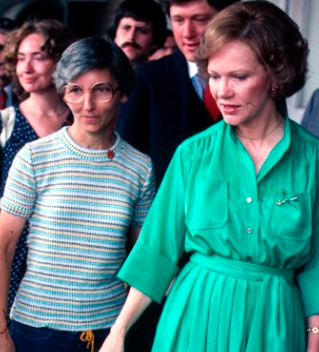 Rosalynn Carter was the first incumbent First Lady that Hillary Clinton came to know in the context of her own role as Arkansas's First Lady, when the former made a visit to the state. Rosalynn Carter was the first incumbent First Lady that Hillary Clinton came to know in the context of her own role as Arkansas's First Lady, when the former made a visit to the state.
In December of 1992, during the busy transition period leading up to her husband's inauguration, Hillary Clinton headlined an event honoring her predecessor, presenting her with the Eleanor Roosevelt Living World Award for her humanitarian efforts, calling her a "voice and a force for democratization and for human opportunity."
|
|
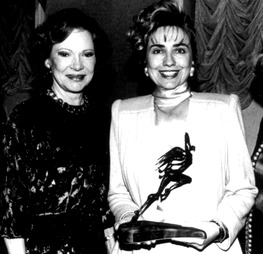
In June 1997, the incumbent Clinton joined her predecessor in working on a "First Ladies House," a Habitat for Humanity project in Pikeville, Kentucky. During the Clinton impeachment trial, Carter praised Clinton for managing to keep her focus on her goals, instead of letting the personal element of it all overwhelm her. As early as 1999, she encouraged the idea of Clinton as a potential woman president.

Hillary Clinton first met Nancy Reagan in the White House, during a 1982 governor's conference state dinner in 1982 and on the subsequent annual events. It was just one year into Clinton's tenure as First Lady that former president Reagan was diagnosed with Alzheimer's disease and the former First Lady kept her attention focused on his care and made only rare appearances outside of California.
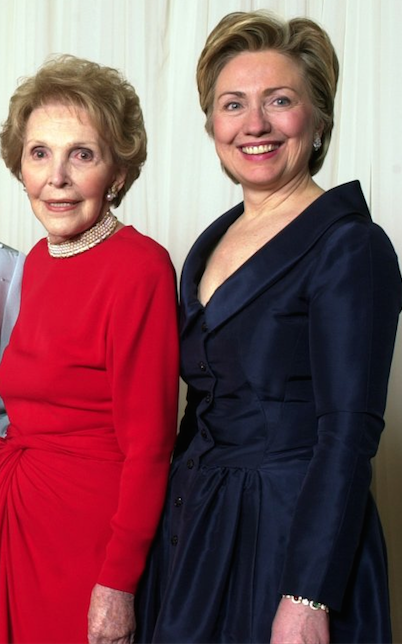
Through the decade of the 1990s they would interact only at a 1994 national arboretum fundraiser and the 1997 George Bush Library dedication. They last saw each other at the 2011 funeral of former First Lady Betty Ford.
As often occurs with the sorority of First Ladies, the acrimony that existed during the 1992 presidential election when their husbands were rivals faded as the decade of the 1990s went on.
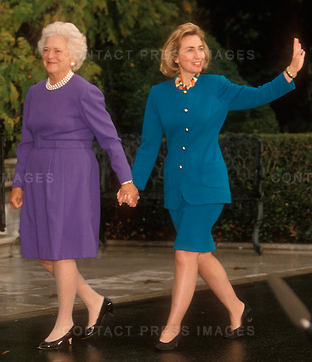 Admittedly, there had been some resentment over the fact that during the 1992 campaign, when speculation arose about whether the Democratic candidate had a mistress, his wife reacted in a Vanity Fair interview by raising similar speculation about his rival. During the Clinton impeachment trial, however, rather than disparage her successor, Mrs. Bush used self-deprecatory humor by remarking, "Why doesn't anyone wonder about me [having an affair]?" Admittedly, there had been some resentment over the fact that during the 1992 campaign, when speculation arose about whether the Democratic candidate had a mistress, his wife reacted in a Vanity Fair interview by raising similar speculation about his rival. During the Clinton impeachment trial, however, rather than disparage her successor, Mrs. Bush used self-deprecatory humor by remarking, "Why doesn't anyone wonder about me [having an affair]?"

When Hillary Clinton first ran for the U.S. Senate, Mrs. Bush had predicted she would lose the election. By the time of Clinton's 2016 presidential campaign, it was reported by news outlets that former President Bush was supporting her over his party's candidate, and some presumed Barbara Bush was doing likewise.
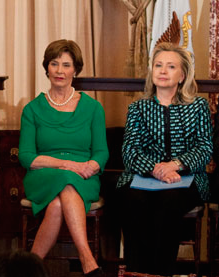 Hillary Clinton, in her capacity as a U.S. Senator, was scheduled to attend the September 11, 2001 intended congressional testimony of her successor Laura Bush on education, but the terrorist attacks that day cancelled the event. Hillary Clinton, in her capacity as a U.S. Senator, was scheduled to attend the September 11, 2001 intended congressional testimony of her successor Laura Bush on education, but the terrorist attacks that day cancelled the event.
In subsequent years, Bush continued Clinton's work on issues involving Afghani women's education and other global women's issues and they jointly participated in a Georgetown University symposium on the topic.
Michelle Obama delivered an impassioned speech at the 2016 Democratic National Convention on behalf of her predecessor's presidential nomination. In contrast, when her husband and Hillary Clinton were rivals battling for their party's nomination in 2008, Mrs. Obama was described as "often fuming about what she viewed as brutal, unfair attacks," according to a July 25, 2016 New York Times article.
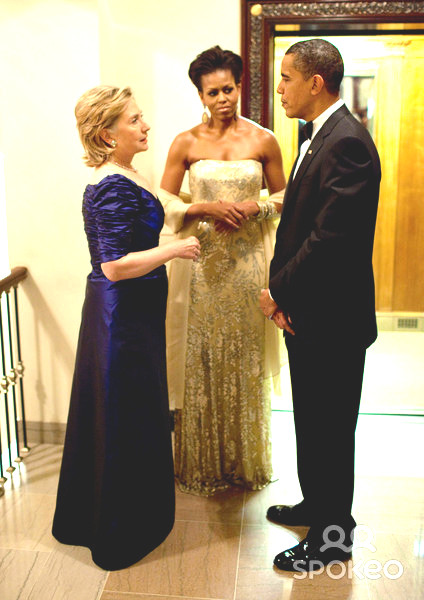
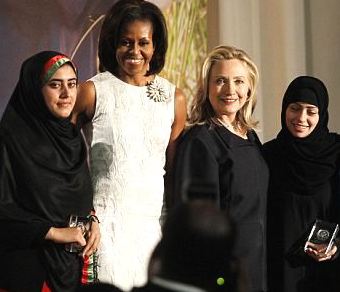 After Clinton accepted the offer to serve as Obama's Secretary of State, the two First Ladies joined together in support of issues of mutual interest, including that of gender pay equity. After Clinton accepted the offer to serve as Obama's Secretary of State, the two First Ladies joined together in support of issues of mutual interest, including that of gender pay equity.
Hillary Clinton was almost fifteen years old at the time of Eleanor Roosevelt's death; although she never crossed paths with her, beginning during the 1992 presidential election, she began reading biographies as well as books and other material written by the former First Lady and she became a strong role model for her own tenure as a presidential spouse.
|
|
Listening Tour & U.S. Senate Campaign:
There was considerable speculation about what the activist First Lady would do upon the end of her husband's presidency. In November of 1998, U.S. Senator Daniel Patrick Moynihan of New York, a Democrat, announced he would not-seek re-election and several advisors urged her to run for the open seat, including New York District Attorney Robert M. Morgenthau whose father, FDR's Treasury Secretary had made the same suggestion to Eleanor Roosevelt after her husband's death.
In February of 1999, her office responded to media inquiries that she was considering making the run. Another presidential family speculated upon by the media as a potential candidate was John F. Kennedy, Jr, but he deferred any decision about seeking public office before his death on July 16, 1999. Eleven days earlier, on July 7, Hillary Clinton announced her formation of an exploratory committee at Moynihan's Delaware County farm.
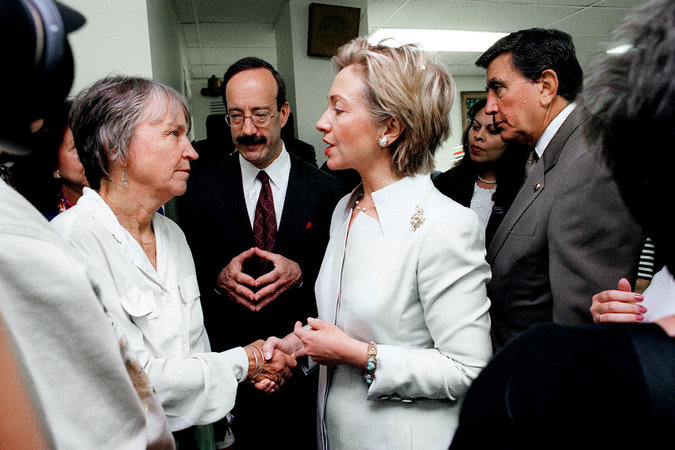 She then commenced what she called a "listening tour" of the state. While some media critics assumed it was nothing more than an effort to enthuse support of local and county Democratic leaders and provide nothing but photographs, she did in fact spend hours each day over the course of several months speaking to individual citizens to gain first-hand knowledge of the general concerns they had and the issues most important to them within the state. Here is an AP News clip showing the start of her effort: She then commenced what she called a "listening tour" of the state. While some media critics assumed it was nothing more than an effort to enthuse support of local and county Democratic leaders and provide nothing but photographs, she did in fact spend hours each day over the course of several months speaking to individual citizens to gain first-hand knowledge of the general concerns they had and the issues most important to them within the state. Here is an AP News clip showing the start of her effort:
Although she had earlier remarked that she and Bill Clinton had planned to move to New York after the presidency, when they purchased a Dutch Colonial house in the town of Chappaqua, in northern Westchester County in September of 1999, political foes depicted it as a cynical move meant simply to establish residency in the state and earn eligibility to serve as its U.S. Senator. By the new year of 2000, the home was furnished and she assumed occupancy.

Her presumptive rival, popular Republican New York City Mayor Rudolph Guiliani, was seen as a formidable challenger. In the spring of 2000, the media learned of the married mayor's mistress, then a revelation he was being treated for prostate cancer, and his estranged wife's announcement she would remain supportive of him through the illness. This was followed by his announcement he was separating from his wife, and her disclosure that he had an earlier mistress.

Hillary Clinton officially declared herself a candidate for the position several months later, announcing in Purchase, New York at the State University of New York, on February 6, 2000. Nominated as the Democratic Senate candidate, the First Lady made no mention or references to Guiliani's health and marital crises, but it had the effect of diffusing potential political damage of the Lewinsky scandal. Congressman Rick Lazio was instead nominated as her opponent.
Mrs. Clinton would manage to maintain a full campaign schedule through the winter, spring and summer of 2000, as she travelled again throughout New York State, yet also fulfill the ceremonial appearances she had committed to as First Lady. She did not do any overseas travel as First Lady. When the President made a state visit to Australia, for example, it was their daughter Chelsea who accompanied him, yet otherwise did not substitute for her mother at any White House events.
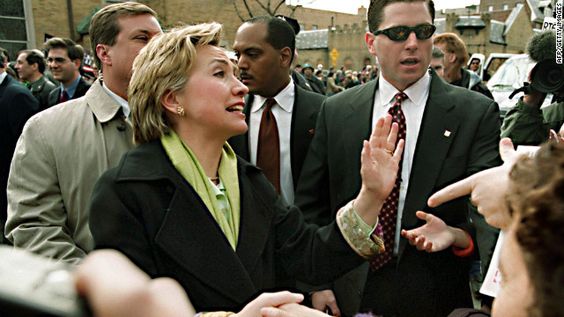 In 2000, Hillary Clinton addressed the Democratic National Convention, held in Los Angeles, marking her second time doing so. She would go on to do so again in 2004 and 2008 as an incumbent Senator, then again in 2016, thus sharing the record with Eleanor Roosevelt who also spoke at five conventions. She did not participate in the 2000 presidential campaign of Democratic nominee Vice President Al Gore. In 2000, Hillary Clinton addressed the Democratic National Convention, held in Los Angeles, marking her second time doing so. She would go on to do so again in 2004 and 2008 as an incumbent Senator, then again in 2016, thus sharing the record with Eleanor Roosevelt who also spoke at five conventions. She did not participate in the 2000 presidential campaign of Democratic nominee Vice President Al Gore.
On November 7, 2000, Hillary Clinton became the first First Lady elected to public office, winning the U.S. Senate seat from New York State with 55% of the vote to Lazio's 43%.
Here is an interview she did with Larry King about her transition from First Lady to Senator:
|
|
Post-Presidential Life:
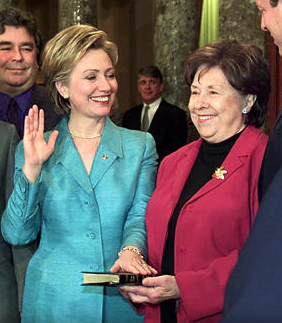 United States Senator: United States Senator:
Sworn in as a U.S. Senator on January 1, 2001 but remaining First Lady until January 20 of that year, Hillary Clinton served simultaneously for twenty days as a member of one branch of government while married to the leader of another branch.
She would not indulge the immediate speculation that she would run for President of the United States in 2004, or then in 2008; instead she focused on and publicly discussed her work, assuming the lower public profile typical of most freshmen Senators.
|
|

Hillary Clinton sat on four Senate Committees with a total of eight subcommittee assignments: Senate Committee on Armed Services with three subcommittee assignments, on Airland, on Emerging Threats and Capabilities, and on Readiness and Management Support; Senate Environment and Public Works Committee with three subcommittee assignments on Clean Air, Wetlands, Private Property, and Nuclear Safety, on Fisheries, Wildlife, and Water and on Superfund, Waste Control, and Risk Assessment; the Senate Health, Education, Labor and Pensions Committee, with two subcommittee assignments, on Aging and on Children and Families; and the Senate Special Committee on Aging.
After the terrorist attacks of September 11, 2001 on the World Trade Center in downtown New York City, Senator Clinton worked to secure $21.4 billion in funding to assist clean up and recovery, to provide health tracking for first responders and volunteers at Ground Zero and to create grants for redevelopment. In 2005, she issued two studies that examined the disbursement of federal homeland security funds to local communities and first responders.
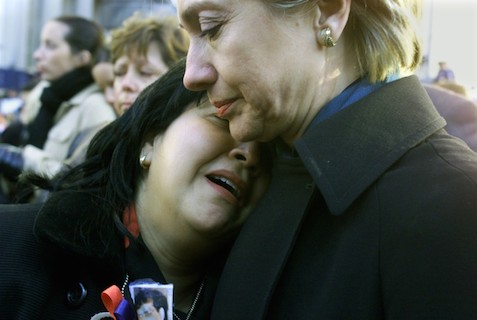
Senator Clinton visited American troops in Afghanistan and Iraq during the U.S. war in those nations. She became a national advocate both in public and in her Senate work on behalf of retaining and improving health and other benefits for veterans.
As an advocate for her state, Senator Clinton led a bipartisan effort to bring broadband access to rural communities; co-sponsored the 21st Century Nanotechnology Research and Development Act; included language in the Energy Bill to provide tax exempt bonding authority for environmentally conscious construction projects; and introduced an amendment calling for funding of new job creation to repair, renovate and modernize public schools. Senator Clinton won an extension of Unemployment Insurance, which passed on the first day of the 108th Congress. She was a vocal opponent of the Bush Administration's tax cuts.

Her memoirs Living History were published in 2003 and sold over 3 million copies both in the U.S. and in other nations; it was eventually translated into foreign languages including Chinese. When her husband, former President Clinton required immediate heart surgery in October of 2004, Senator Clinton cancelled her public schedule to be with him.
In 2006, Senator Clinton sought re-election and won a second term as U.S. Senator with 67% of the vote, her Republican opponent Yonkers mayor John Spencer garnering 31%.

She would serve only two of the six years of this term, however. Just twenty days after beginning her second term as Senator she made known her intention to pursue the 2008 Democratic presidential nomination; she spent the first half of her final year in the Senate as a full-time contender for her party's bid for the highest office in the land.
Here is an NBC News review of her Senate career as well as her 2008 presidential campaign:
|
|
2008 Democratic Presidential Candidate:
On January 20, 2007, two years to the day before the next presidential inauguration, Senator Clinton filed with the Federal Elections Commission to declare her formation of an exploratory presidential campaign committee. She made a video announcing her intentions on her website. Nine months later, she formally declared her candidacy for the U.S. Presidency.
 This was unprecedented. Clinton proved to be the first woman in history who occupied a position of elective national office as a member of a national party to enter and remain in a presidential primary race to the end of the season. This was unprecedented. Clinton proved to be the first woman in history who occupied a position of elective national office as a member of a national party to enter and remain in a presidential primary race to the end of the season.
She was also, of course, the only wife of a former President to enter any type of electoral race on a national level and the unusual precedent vied only with her own record in having run for and been elected to the U.S. Senate, since no other First Lady had stood for public office. Eleanor Roosevelt's role at the United Nations was appointed. The only remotely close situation occurred in the years of the American Revolution before her husband's presidency when Abigail Adams was chosen among several leading Boston women supporters of the war to serve as a "judgess" in determining the penalty to be imposed on Tory women loyal to the English monarchy.
Throughout the end of 2007 and into early 2008, Senator Clinton joined in several debates with all the other Democratic presidential candidates. In January of 2008, she began the primary season, campaigning across the country, and continuing her fundraising, which would total over $100 million.
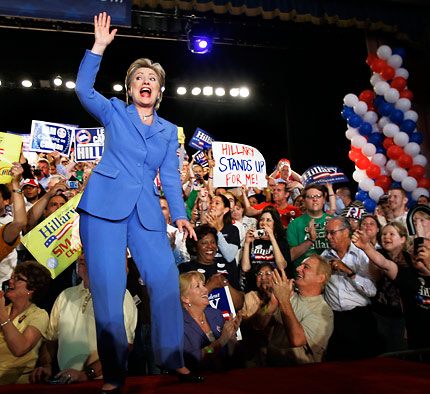
Although she had been predicted through 2007 as the favored candidate and likely nominee of her party, she found her Senate colleague Barack Obama, who represented her own native state of Illinois to be a formidable challenger. Despite her many political achievements as First Lady, it proved difficult to emphasize them since she had done so in a position that was neither official nor elective.
Among the states she won in the primaries were New Hampshire, California, New York, Texas, Pennsylvania, Ohio, North Carolina and Indiana. Senator Clinton garnered 1,896 delegates; a total of 2,201 were required for the nomination.
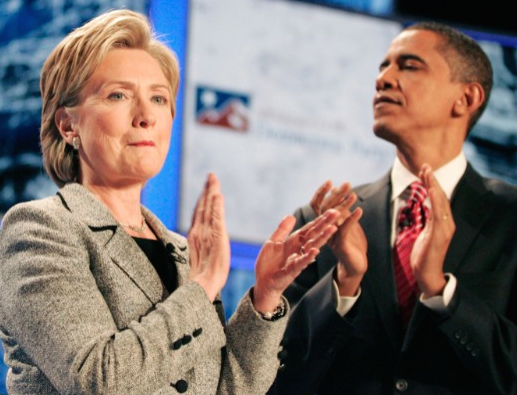 On June 3, 2008, Senator Obama won the necessary number of delegate pledges. Hillary Clinton suspended her campaign several days later and delivered a stirring concession speech in Washington, D.C. to her supporters, emphasizing that she was not interested in having a cult personality following but in her party achieving dramatic change in the executive branch. On June 3, 2008, Senator Obama won the necessary number of delegate pledges. Hillary Clinton suspended her campaign several days later and delivered a stirring concession speech in Washington, D.C. to her supporters, emphasizing that she was not interested in having a cult personality following but in her party achieving dramatic change in the executive branch.
Mrs. Clinton addressed the National Democratic Convention and endorsed the candidacy of Obama. Throughout the fall, she campaigned vigorously on his behalf and after he won the 2008 election, he named her as his Secretary of State. Here is a CSpan recording of her convention speech:
|
|
Secretary of State:
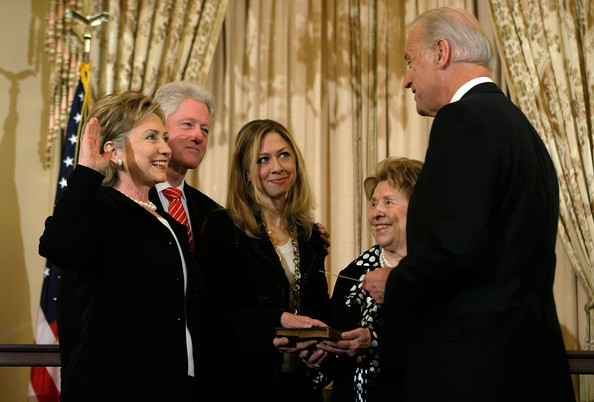 In January of 2009, Hillary Clinton became the 67th Secretary of State, the third woman and the only former First Lady to serve in this capacity. In January of 2009, Hillary Clinton became the 67th Secretary of State, the third woman and the only former First Lady to serve in this capacity.
The position's duties are to serve as the primary advisor on foreign affairs to the President and also enact presidential policy decisions through her department, which also includes the U.S. Foreign Service. She is also responsible for negotiating with foreign leaders on policy and treaties, granting passports, suggesting and advising the President on individuals for the posts of ambassador, consul and minister, and on which foreign government representatives to receive or dismiss.

A great part of Secretary Clinton's public role was in leading or joining global conferences and other international meetings on a variety of issues. She was also considered responsible for the protection of U.S. property and citizens that are in foreign countries, and oversees the administration of U.S. immigration laws abroad. Further, at her recommendation and approval, warnings and other necessary postings were made to alert American citizens traveling abroad in case their well-being is considered to be potentially threatened.
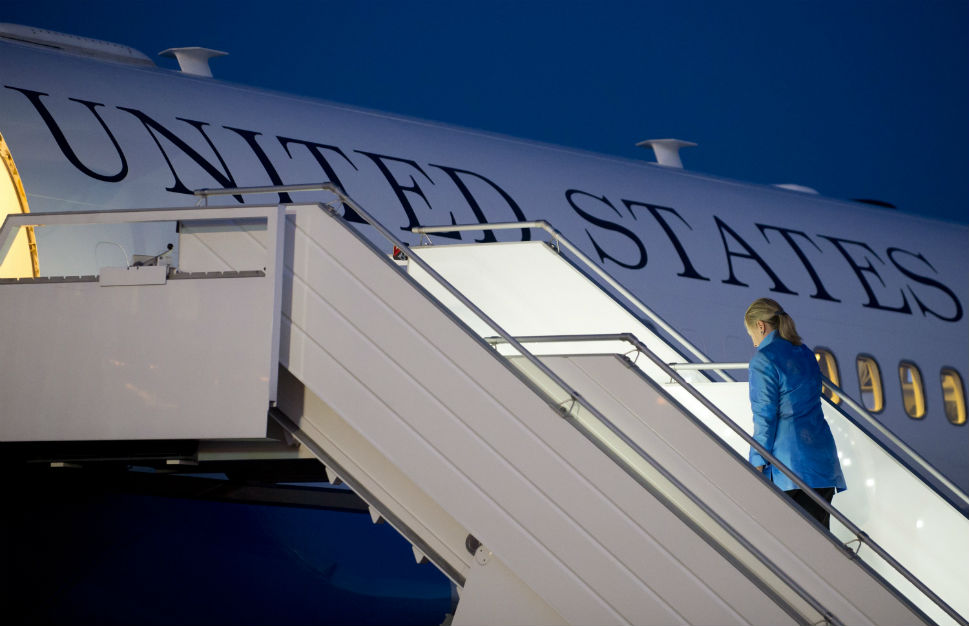
Halfway through the first term of the Obama Administration, Secretary Clinton had traveled over half a million miles to 77 countries.
She has employed not only the diplomatic tactics traditionally used by those in her position, but political skills also learned through her White House and Senate years. She often presented a tough stance on behalf of the United States with both allies and aggressors towards it. She called the action of U.S. ally Israel of building settlements in disputed areas with Palestine to be "insulting," threatened action along with urging Iran to forego a nuclear weapons development, and harshly criticized the firing of short-range missiles by North Korea into South Korea as "provocative and belligerent behavior," as "threatening peace and stability in Asia."
 A strong supporter of fighting the war on terror in Afghanistan, stating its long-time security as crucial to global safety, she vigorously urged that nation's beleaguered president Harmad Kharzi into assuming a more pro-active role in reducing the terrorist influence of the Taliban in his country. She was also the leading American voice criticizing the 2010 disclosures of confidential information through Wikileaks. A strong supporter of fighting the war on terror in Afghanistan, stating its long-time security as crucial to global safety, she vigorously urged that nation's beleaguered president Harmad Kharzi into assuming a more pro-active role in reducing the terrorist influence of the Taliban in his country. She was also the leading American voice criticizing the 2010 disclosures of confidential information through Wikileaks.
As Secretary of State, Hillary Clinton focused special attention beyond her required duties to focus on the international rights of women, economic empowerment in financially depressed regions of the world, and held "town hall" type meetings with direct questioning from the public, whether in the United States or other countries. Equal access to education, employment, health care and legal recourse for women in all countries has been an unwavering aspect of her career from First Lady to Senator to Secretary of State. Melanne Verveer, who had served as Hillary Clinton's Chief of Staff during her years as First Lady, aided her in this effort. Verveer served as a State Department Ambassador-at-Large and ran its Office of Global Women's Issues, focused on the political, economic, and social empowerment of women.
 Working with Verveer, Secretary Clinton also began serving as honorary founding chair of the Georgetown Institute for Women, Peace and Security. On December 19, 2011, she launched the U.S. National Action Plan on Women, Peace and Security at Georgetown University and announced the creation of the Institute. Working with Verveer, Secretary Clinton also began serving as honorary founding chair of the Georgetown Institute for Women, Peace and Security. On December 19, 2011, she launched the U.S. National Action Plan on Women, Peace and Security at Georgetown University and announced the creation of the Institute.
Another woman who has been with Mrs. Clinton since her White House years is Huma Abedin, who has worked as her primary and indispensible personal aide, traveling across the U.S. with her during the 2008 campaign, continuing that duty in the role of traveling chief of staff at the State Department and later during the 2016 presidential primary and general campaigns.
Secretary Clinton used the venue of an open town-hall type forum to deliver addresses on policy and also take questions from the press and public. She gave almost one dozen of these in just her first two years as Secretary of State in Washington, D.C.
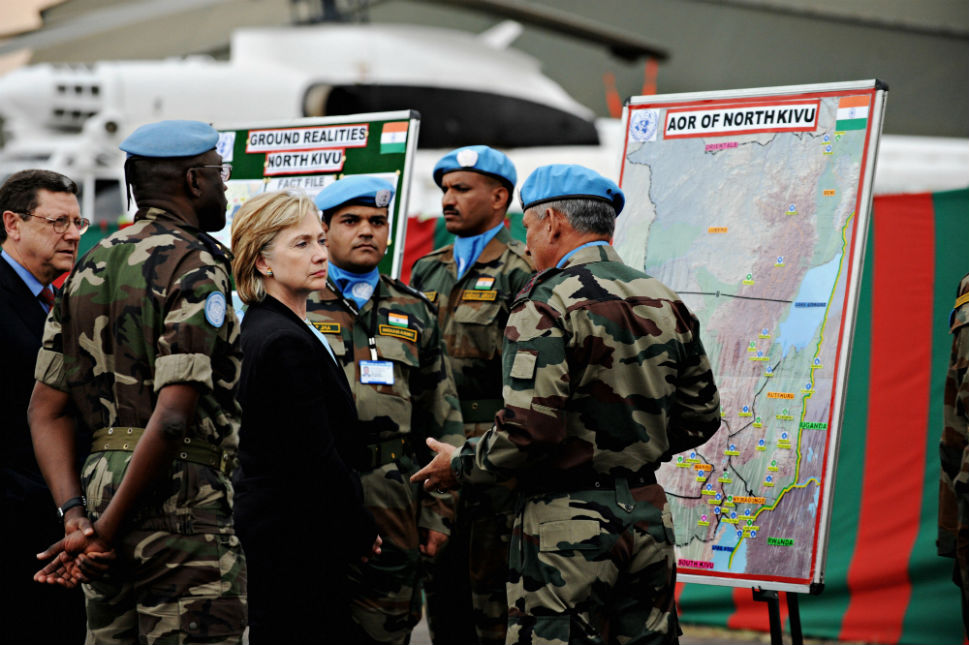
She also conducted the town-hall interviews around the world, giving a sense of the breadth of her travels: Manama, Bahrain, Bishkek, Kyrgyzstan, Astana, Kazakhstan, Melbourne, Australia, Christchurch, New Zealand, Kuala Lumpur, Malaysia, Phnom Penh, Cambodia, Pristina, Kosovo, Sarajevo, Bosnia and Herzegovina, Islamabad, Pakistan (twice), Tbilisi, Georgia, Kyiv, Ukraine, Sao Paulo, Brazil, Doha, Qatar, Manila, Philippines, Lahore, Pakistan, Moscow, Russia, Abuja, Nigeria, Kinshasa, Democratic Republic of the Congo, Nairobi, Kenya, Bangkok, Thailand, New Delhi, India, Mumbai, India, Baghdad, Iraq, Santo Domingo, Dominican Republic, Monterrey, Mexico, Brussels, Belgium, Seoul, South Korea, and Tokyo, Japan.
Apart from the substantive work she conducted as Secretary of State, Clinton's global travels also exposed her to an even wider perspective on the world's different nations and cultures. On appropriate occasions, she joined in local traditional customs.
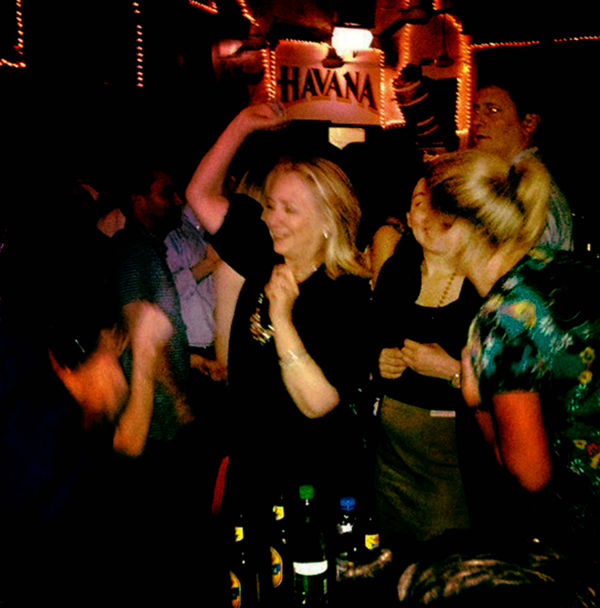 Hillary Clinton continued to enjoy a diverse and unprecedented career in public service. In a 15 July 2009 speech to the Council on Foreign Relations, she offered her forecast of the challenges and opportunities of the U.S. as it entered the second decade of the 21st Century: Hillary Clinton continued to enjoy a diverse and unprecedented career in public service. In a 15 July 2009 speech to the Council on Foreign Relations, she offered her forecast of the challenges and opportunities of the U.S. as it entered the second decade of the 21st Century:
"We are determined to channel the currents of change toward a world free of violent extremism, nuclear weapons, global warming, poverty, and abuses of human rights, and above all, a world in which more people in more places can live up to their God-given potential."
Despite the fact that they had been sharp rivals for their party's nomination, President Obama and Secretary Clinton developed a strong rapport and working relationship from the start of the Administration. He was especially impressed by how she had fulfilled her promise to work for his election. He was certain to always consult with and include her in all the international crises he faced and the responses he chose to meet them.
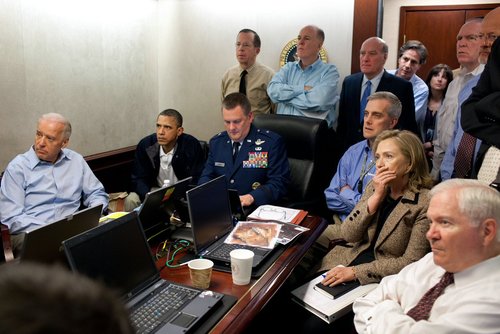 There were no reports of any disagreements between them on a wide range of issues, including the terrorist threat and he made certain, for example, that she was included in the Situation Room gathering when he and other officials watched US forces invade the secret base of Al Qaida terrorist leader Osama Bin Laden, and stage his capture and demise. After the fact, the President was circumspect in his reaction to learning the news of the Secretary's use of a private email server and did not speculate on whether or not this had compromised any top secret or sensitive information. There were no reports of any disagreements between them on a wide range of issues, including the terrorist threat and he made certain, for example, that she was included in the Situation Room gathering when he and other officials watched US forces invade the secret base of Al Qaida terrorist leader Osama Bin Laden, and stage his capture and demise. After the fact, the President was circumspect in his reaction to learning the news of the Secretary's use of a private email server and did not speculate on whether or not this had compromised any top secret or sensitive information.
|
|
Here is a CNN interview with Clinton as she neared the end of her time as Secretary of State:
Given her past status as a First Lady but also the then-current U.S. Secretary of State, the world media continued to take an interest in the personal life of Hillary Clinton, from her pantsuit fashions to her text messaging to the July 2010 wedding of her only child, daughter Chelsea.
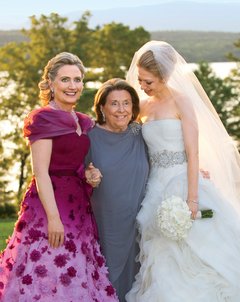 Upon the completion of the first Obama term, Hillary Clinton resigned her position as Secretary of State and began delivering paid speeches; some of these, to banking interests would later stir speculation since the text of her remarks were not released. She also spent her post-Cabinet years writing and publishing her second memoir, Hard Choices, in 2013, chronicling her years as Secretary of State. Upon the completion of the first Obama term, Hillary Clinton resigned her position as Secretary of State and began delivering paid speeches; some of these, to banking interests would later stir speculation since the text of her remarks were not released. She also spent her post-Cabinet years writing and publishing her second memoir, Hard Choices, in 2013, chronicling her years as Secretary of State.
On June 13, 2015, in Four Freedoms Park on Roosevelt Island, New York, Hillary Clinton formally launched her second bid for her party's presidential nomination and, she hoped, the general election for the presidency in 2016. While the conventional wisdom held that she was almost certainly going to be the party's nominee, she would face a strong challenge from U.S. Senator Bernie Sanders of Vermont; later, Maryland Governor Martin O'Malley would enter the contest as the third
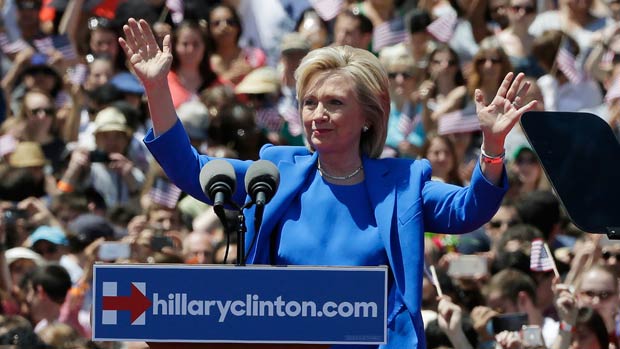 Garnering great public attention just months before the 2016 presidential primary elections began was Hillary Clinton's eleven hours of live-televised testimony in October 2015 before a congressional investigatory committee on her decision-making process during and after the terrorist killing of US government officials at Benghazi, Libya. Garnering great public attention just months before the 2016 presidential primary elections began was Hillary Clinton's eleven hours of live-televised testimony in October 2015 before a congressional investigatory committee on her decision-making process during and after the terrorist killing of US government officials at Benghazi, Libya.
Hillary Clinton's tenure as Secretary of State was not without controversy, notably the Benghazi attack, and her use of a personal server at her home where she stored private emails that were then deleted. These two issues were the primary controversies that were raised against Hillary Clinton as she again ran for the Democratic presidential nomination during the first half of 2016.
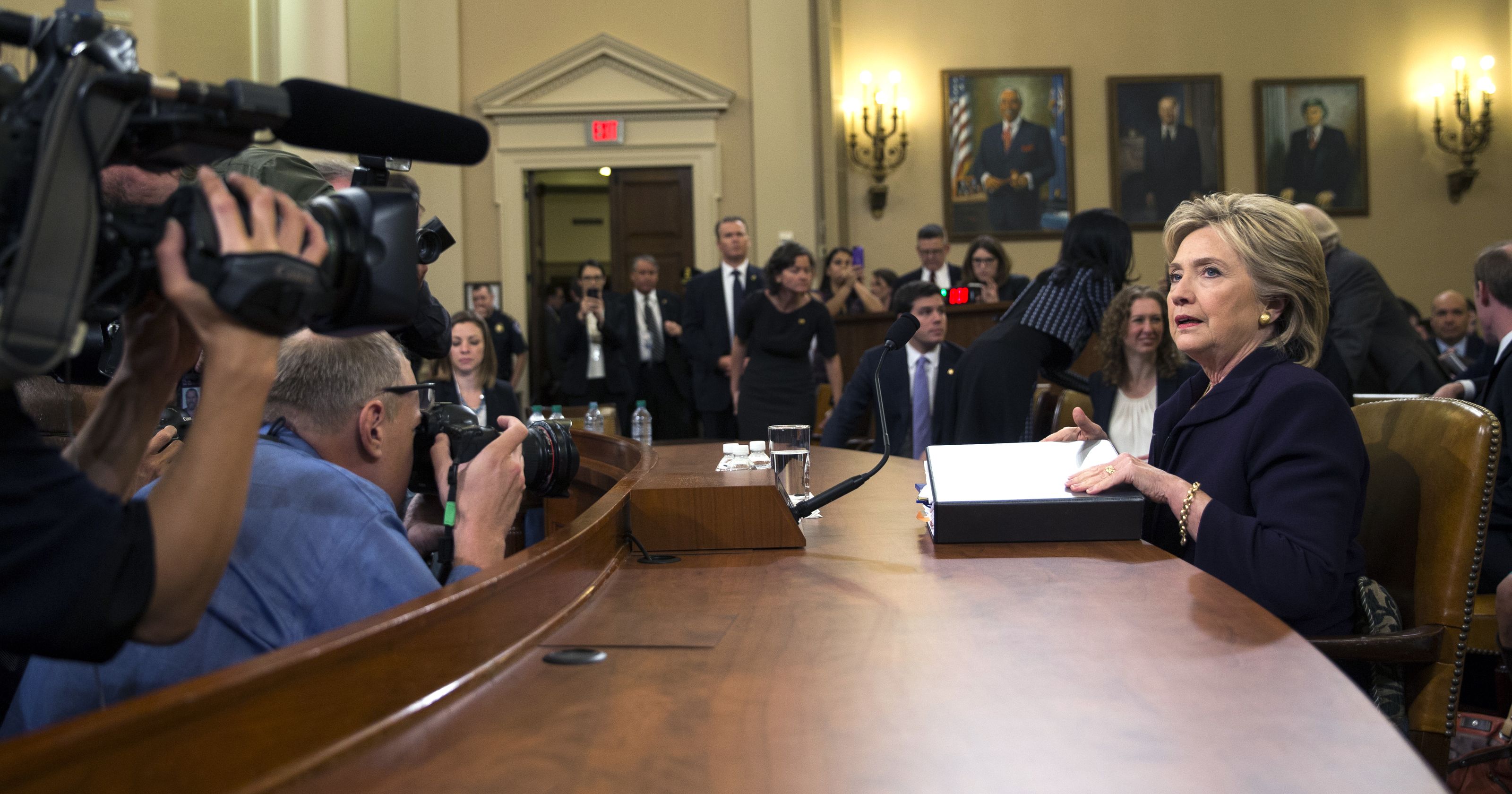
|
|
Nomination for the Presidency:
During the primaries, following her attendance of the funeral of former First Lady Nancy Reagan, Hillary Clinton remarked in an interview that her predecessor was due credit for some of her responses to the AIDS crisis which evolved over the course of the eight-year Reagan Administration. It provoked a backlash of criticism from within the base of the Democratic Party.
As the 2016 primary season ensued, Hillary Clinton was increasingly challenged by Senator Sanders to release the transcripts of her speeches to banking interests for high speaking fees, made in the period immediately following the end of her tenure as Secretary of State. By defining his campaign as a larger movement in the interest of those increasingly disenfranchised by their government, Clinton's was cast as the representative of the establishment, intent on maintaining the status quo.
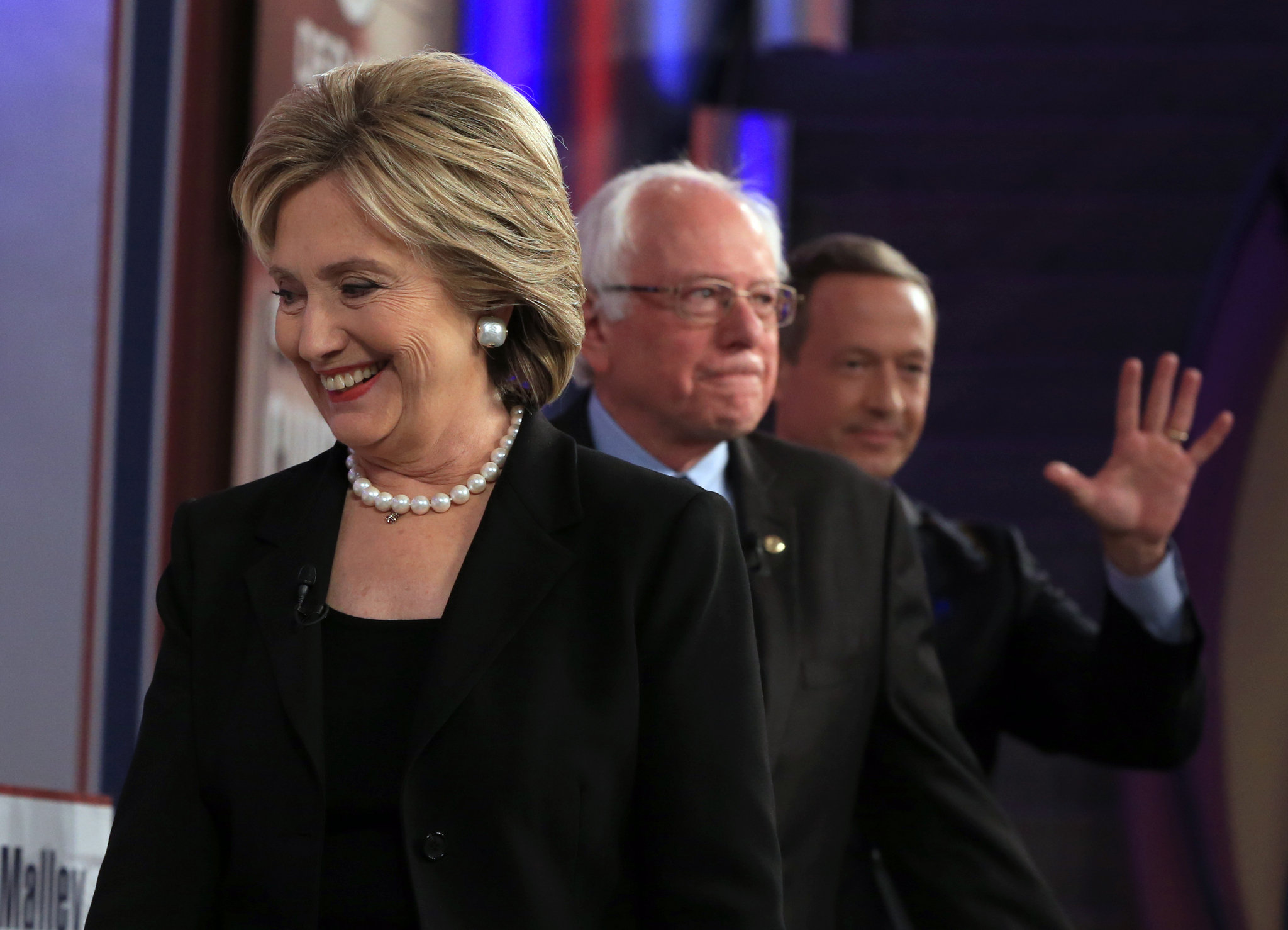 She attained the necessary number of pledged delegates and super-delegates through the primary system on June 6, 2016 and was endorsed by Sanders on July 12. Ten days later, she announced her selection of choice of U.S. Senator Tim Kaine of Virginia as her vice presidential running mate. She attained the necessary number of pledged delegates and super-delegates through the primary system on June 6, 2016 and was endorsed by Sanders on July 12. Ten days later, she announced her selection of choice of U.S. Senator Tim Kaine of Virginia as her vice presidential running mate.
On Tuesday, July 26, 2016 Hillary Clinton won the Democratic nomination for the presidency during the state roll call. Two days later, on July 28, 2016, Hillary Clinton accepted the Democratic nomination for President of the United States that had been formally declared the day before during the roll call of the states. She is the first woman in American history to win a major-party nomination for the presidency.
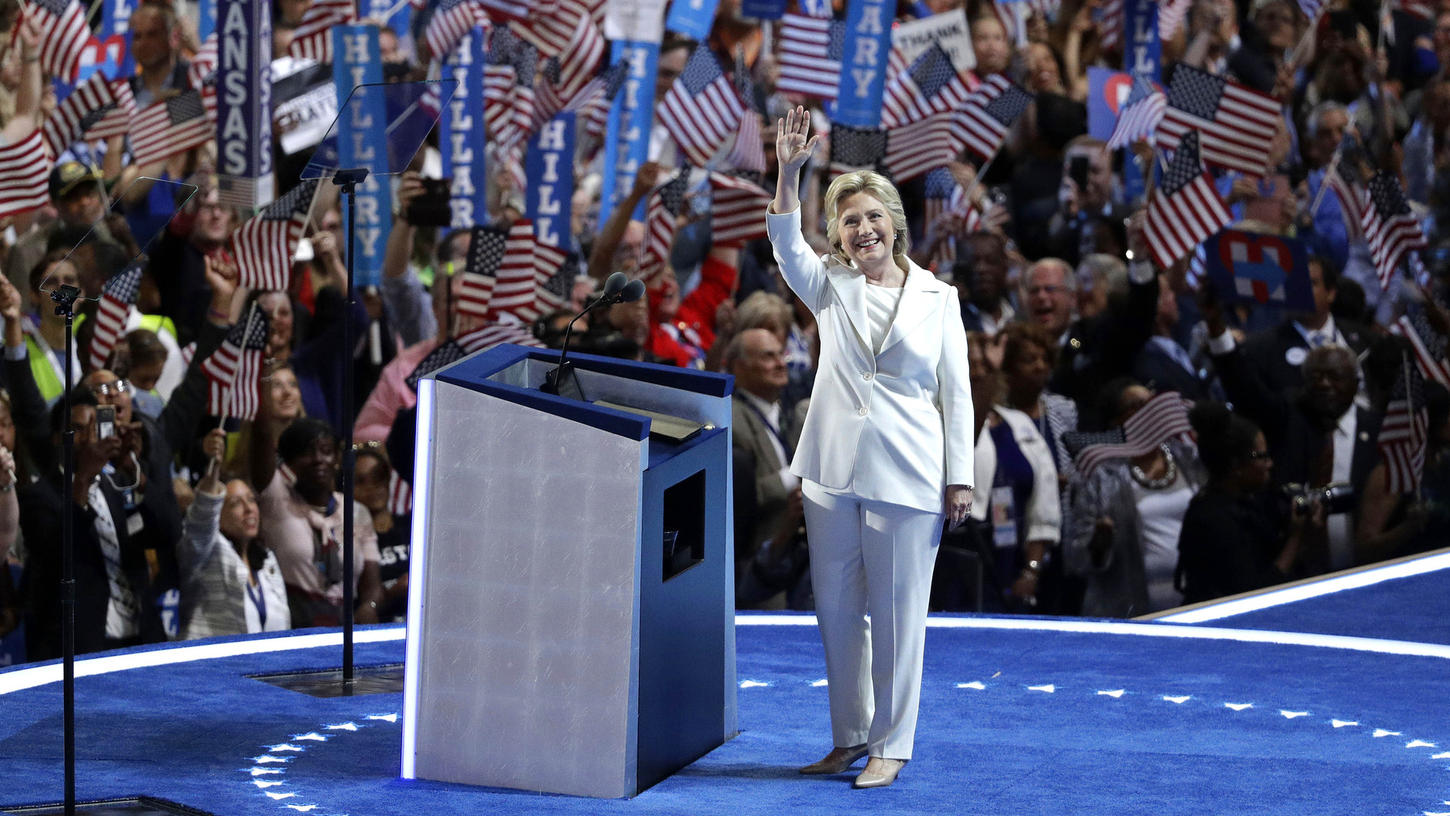 In her acceptance speech, Hillary Clinton quoted one of her predecessors and friends, Jacqueline Kennedy, on the substantive matter of nuclear weaponry reduction quoting from the late First Lady's letter to Soviet premier Nikita Khrushchev, giving focus to concern not of the leaders of large nations but the tyrants and dictators of smaller countries. Here is her full acceptance speech, as introduced by her daughter: In her acceptance speech, Hillary Clinton quoted one of her predecessors and friends, Jacqueline Kennedy, on the substantive matter of nuclear weaponry reduction quoting from the late First Lady's letter to Soviet premier Nikita Khrushchev, giving focus to concern not of the leaders of large nations but the tyrants and dictators of smaller countries. Here is her full acceptance speech, as introduced by her daughter:
Clinton faced the general election challenge of the Republican nominee, New York businessman and builder Donald Trump. Apart from the historical turning point of a woman being nominated by a major party for the American presidency was the novelty of having a former First Lady nominated for the position once held by her husband.
 The two presidential candidates first faced each other in a direct debate on September 26, 2016. It was conservatively estimated that 81.4 million viewers watched the event live, the largest audience for any of the televised presidential debates. The two presidential candidates first faced each other in a direct debate on September 26, 2016. It was conservatively estimated that 81.4 million viewers watched the event live, the largest audience for any of the televised presidential debates.
Along with the speculation about the former First Lady as a potential president there inevitably has come questions about how former President Bill Clinton would seek to define the public role of presidential spouse from the perspective of the first male to potentially hold that position.

Although she won the popular vote, Hillary Clinton lost the electorate vote and thus the presidential election on Tuesday, November 8, 2016.
|